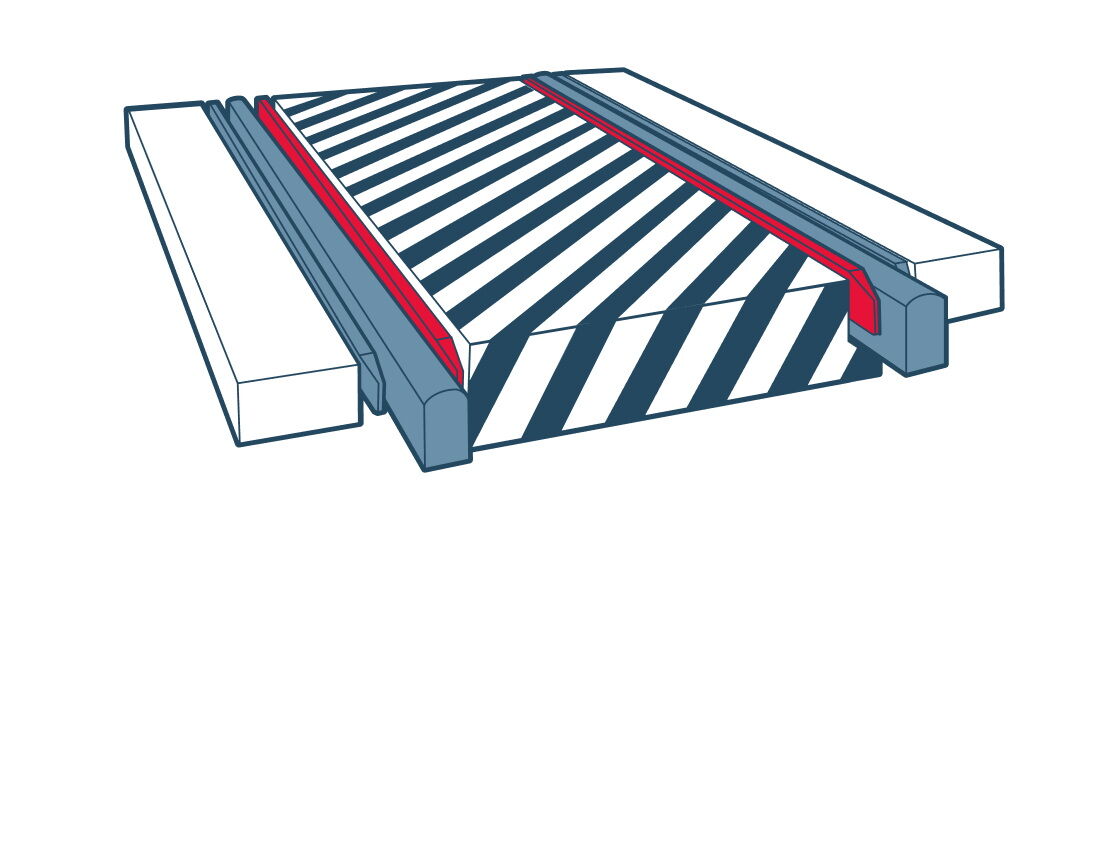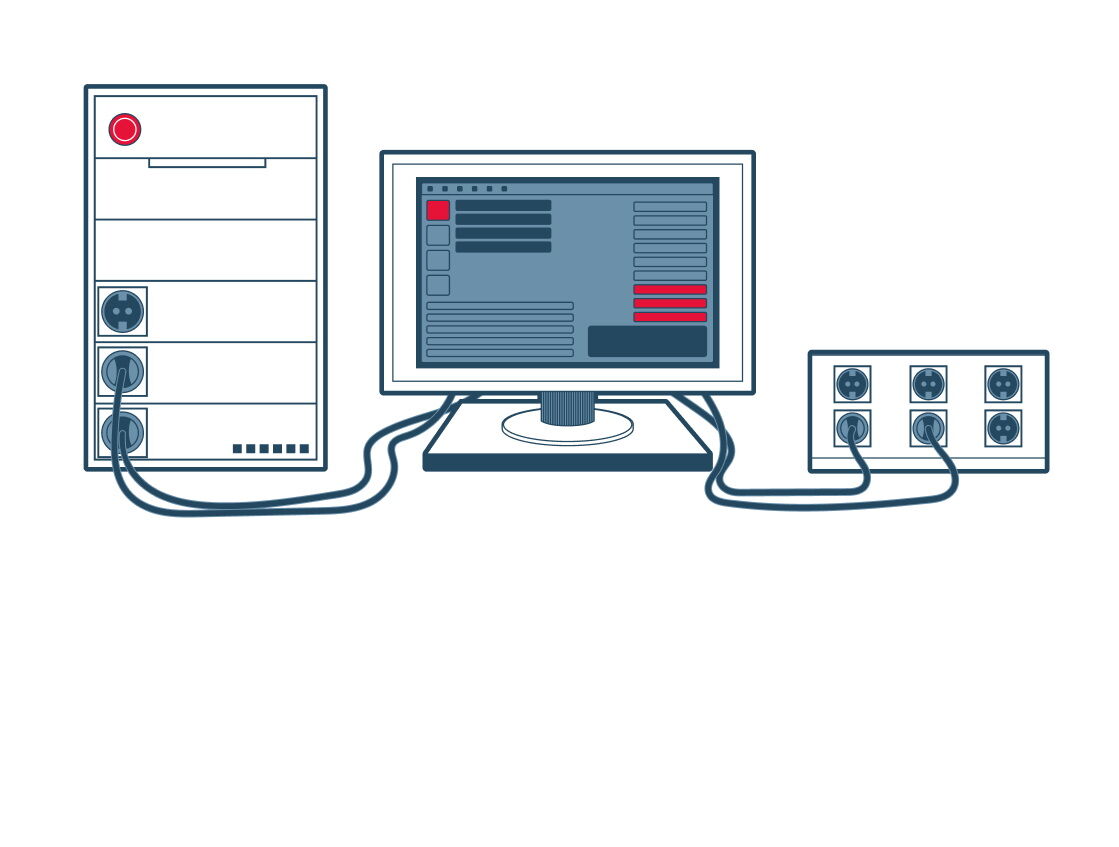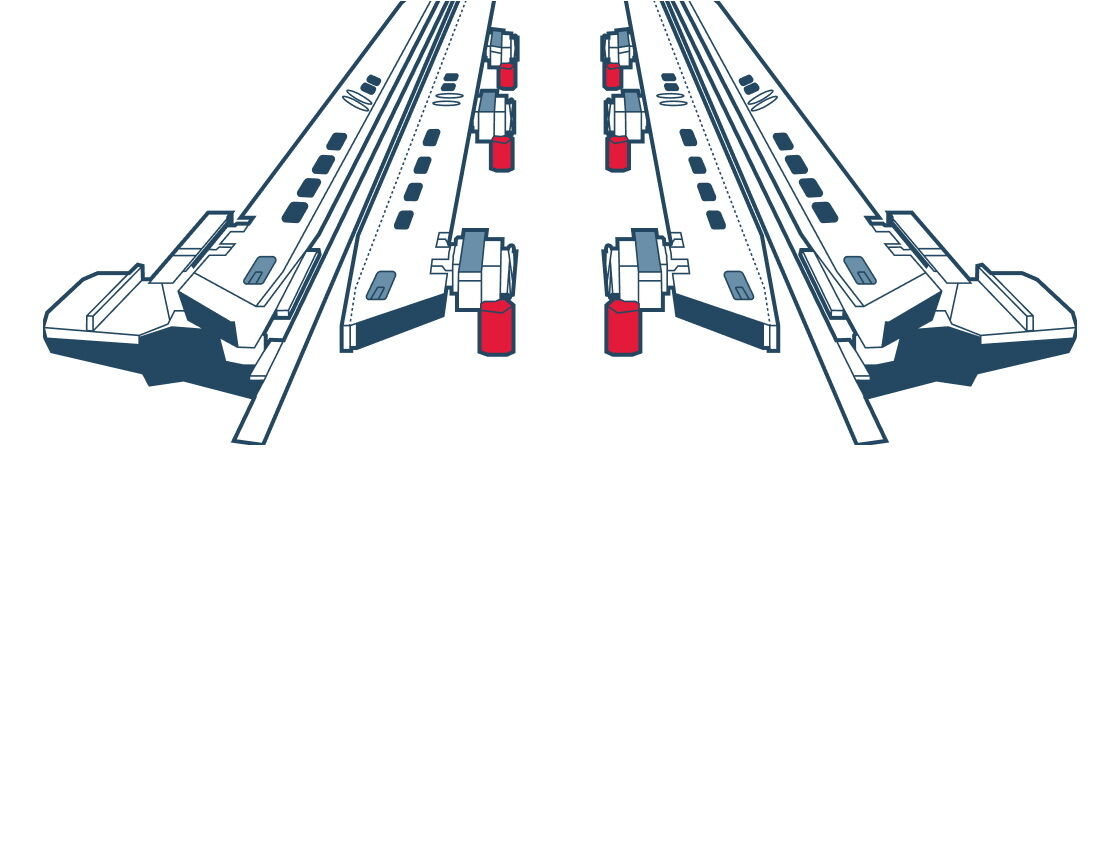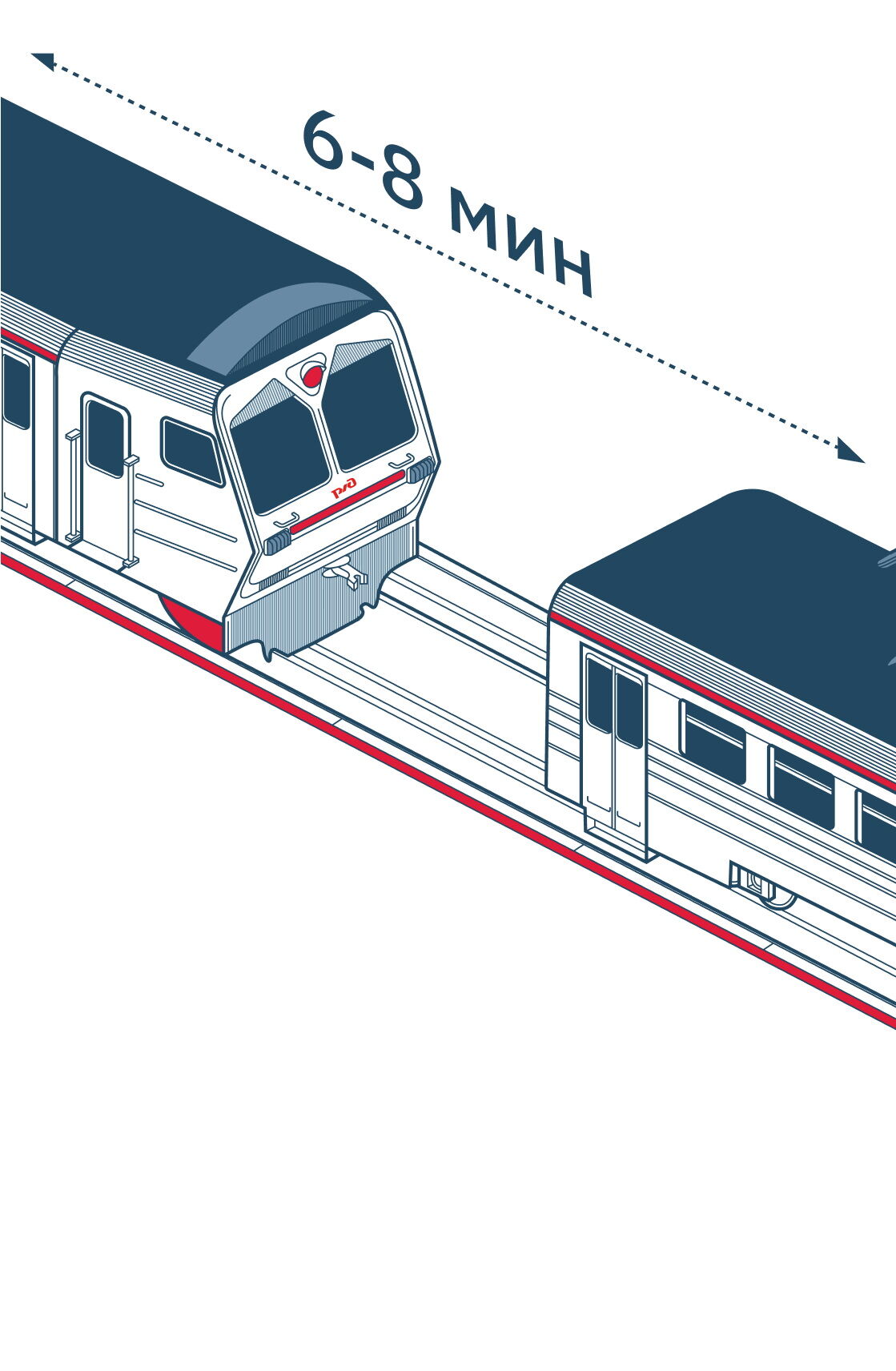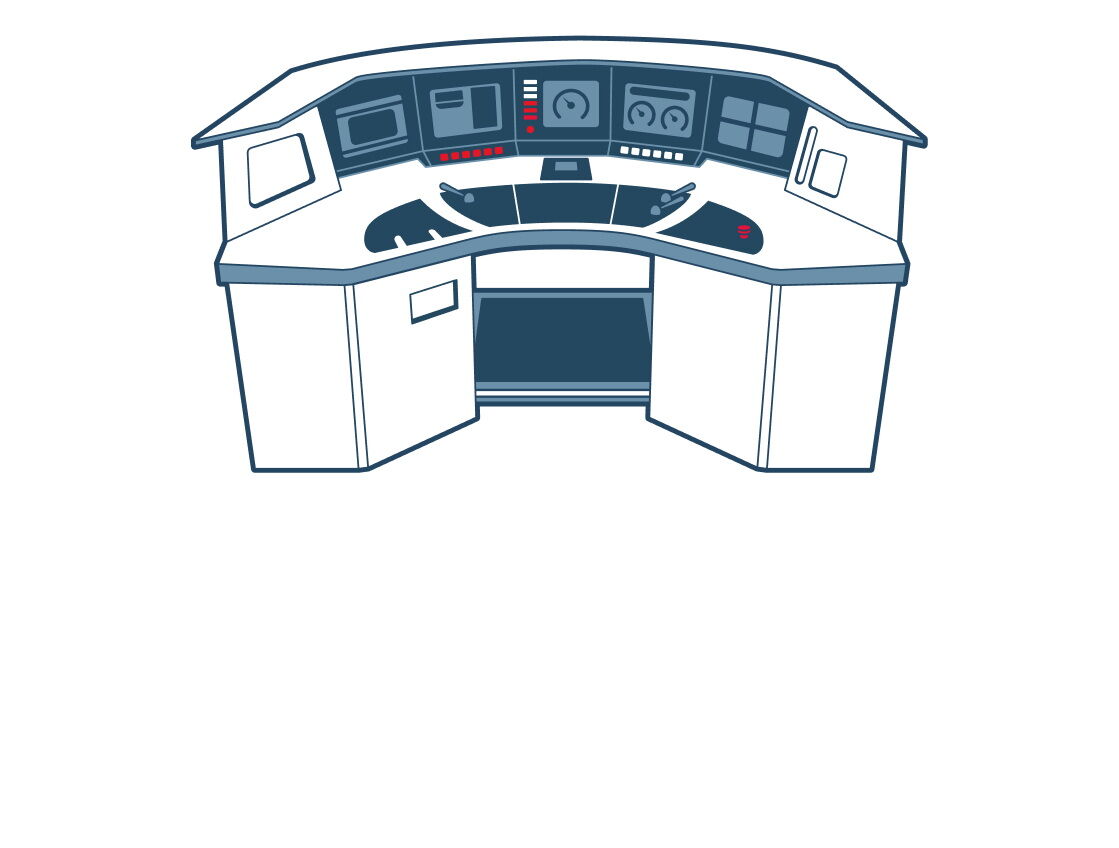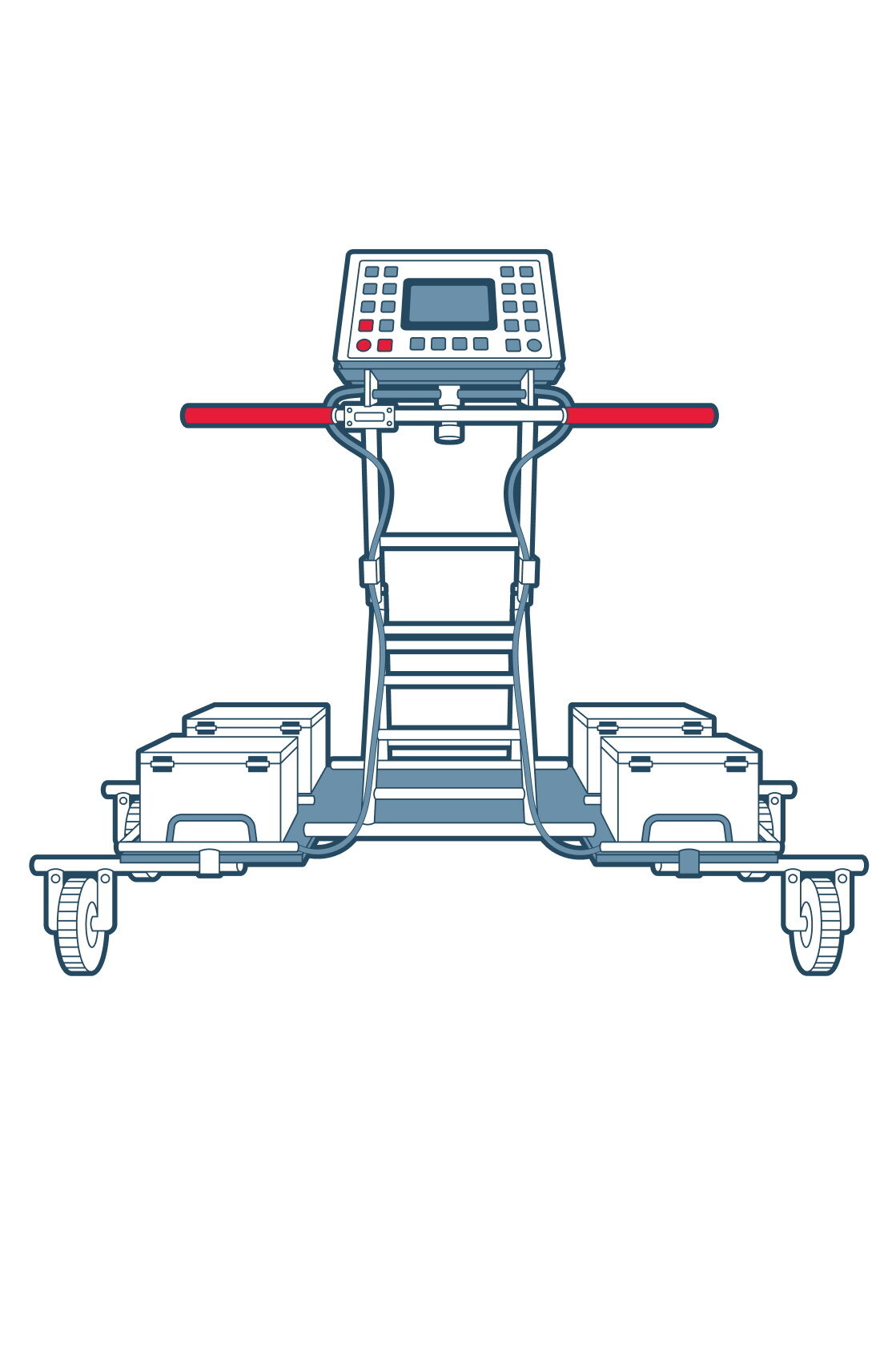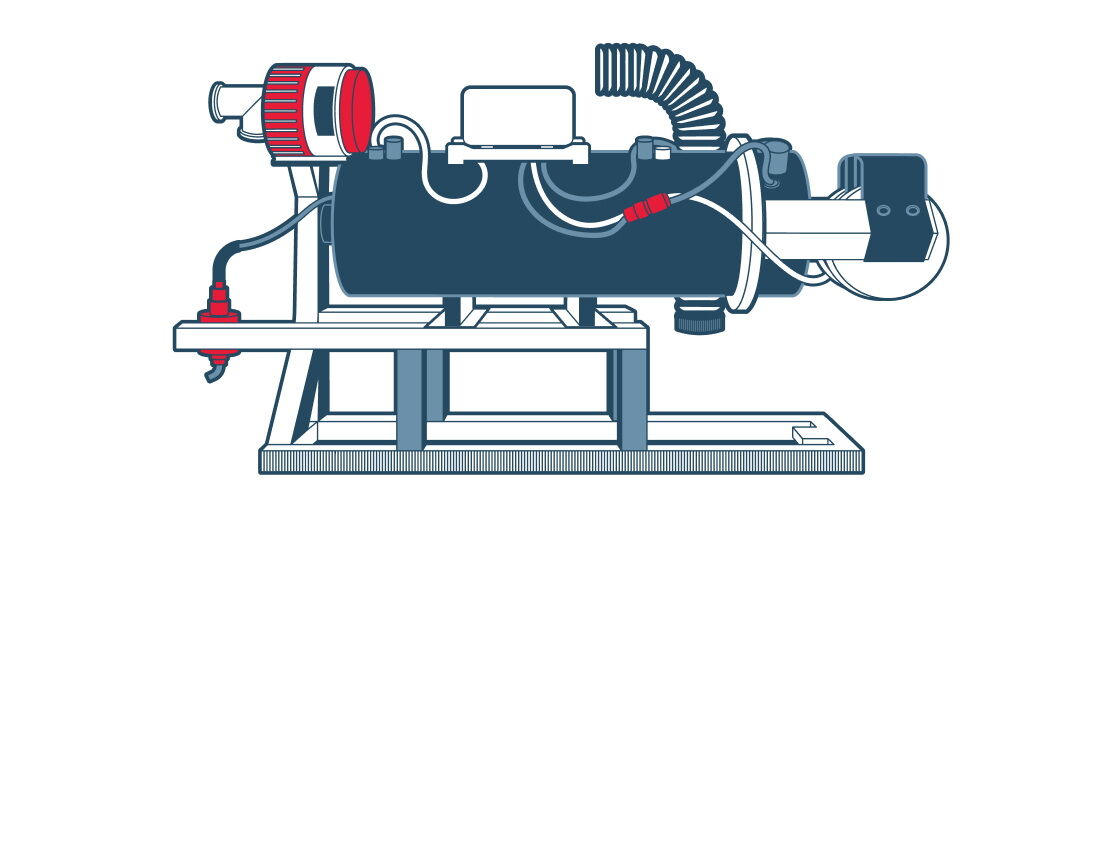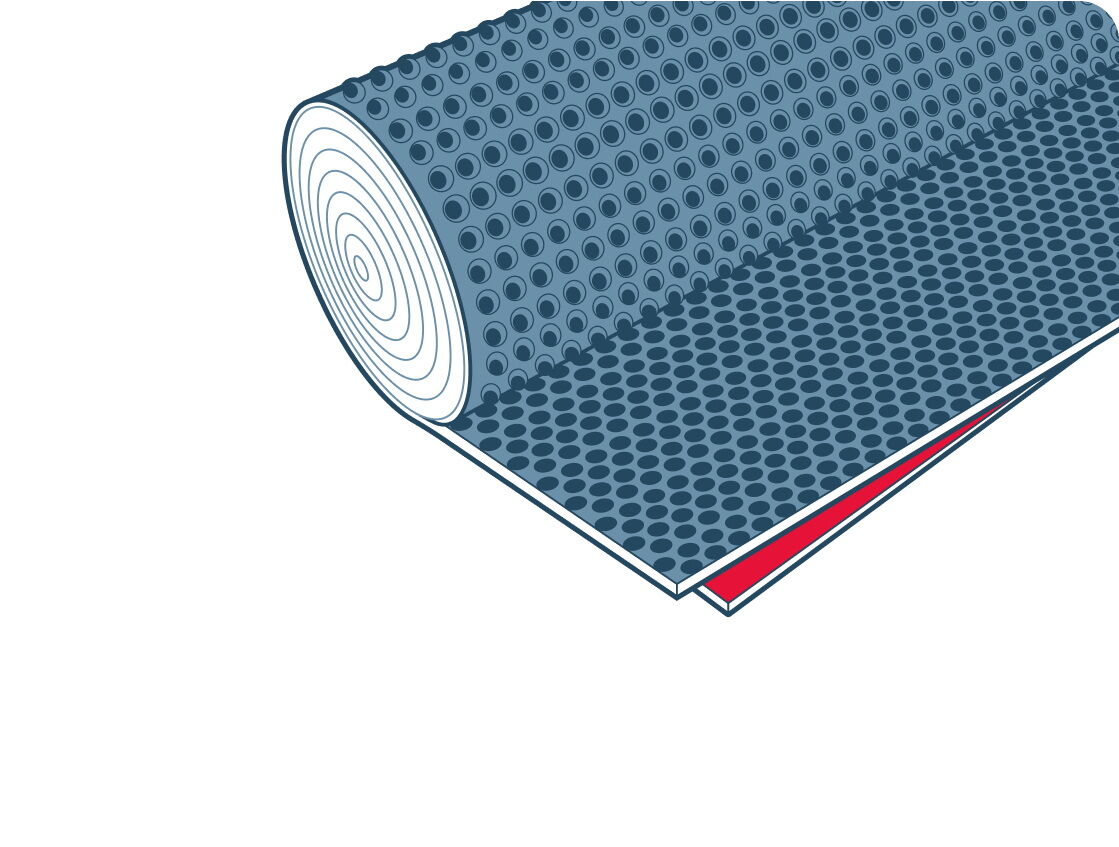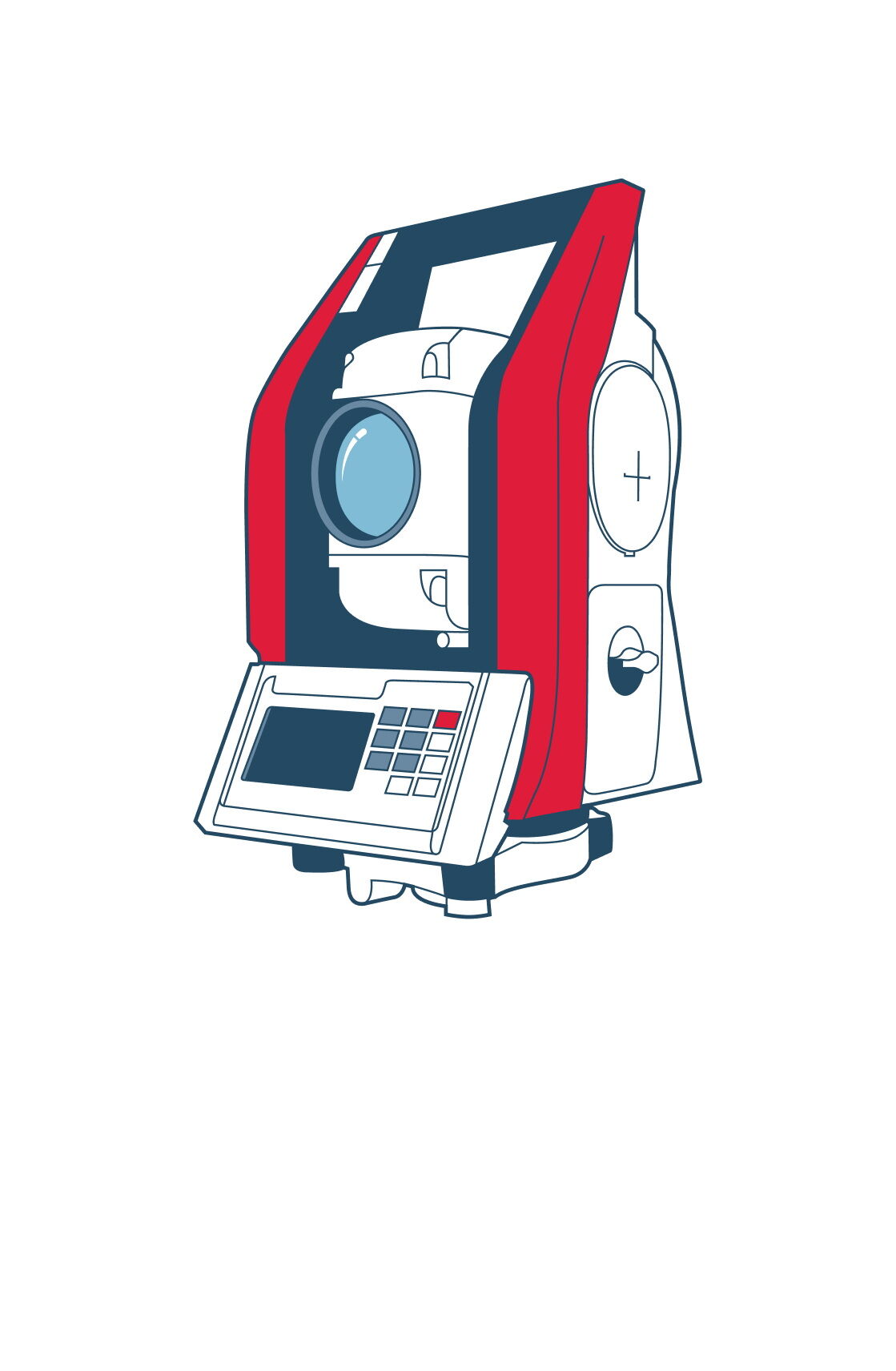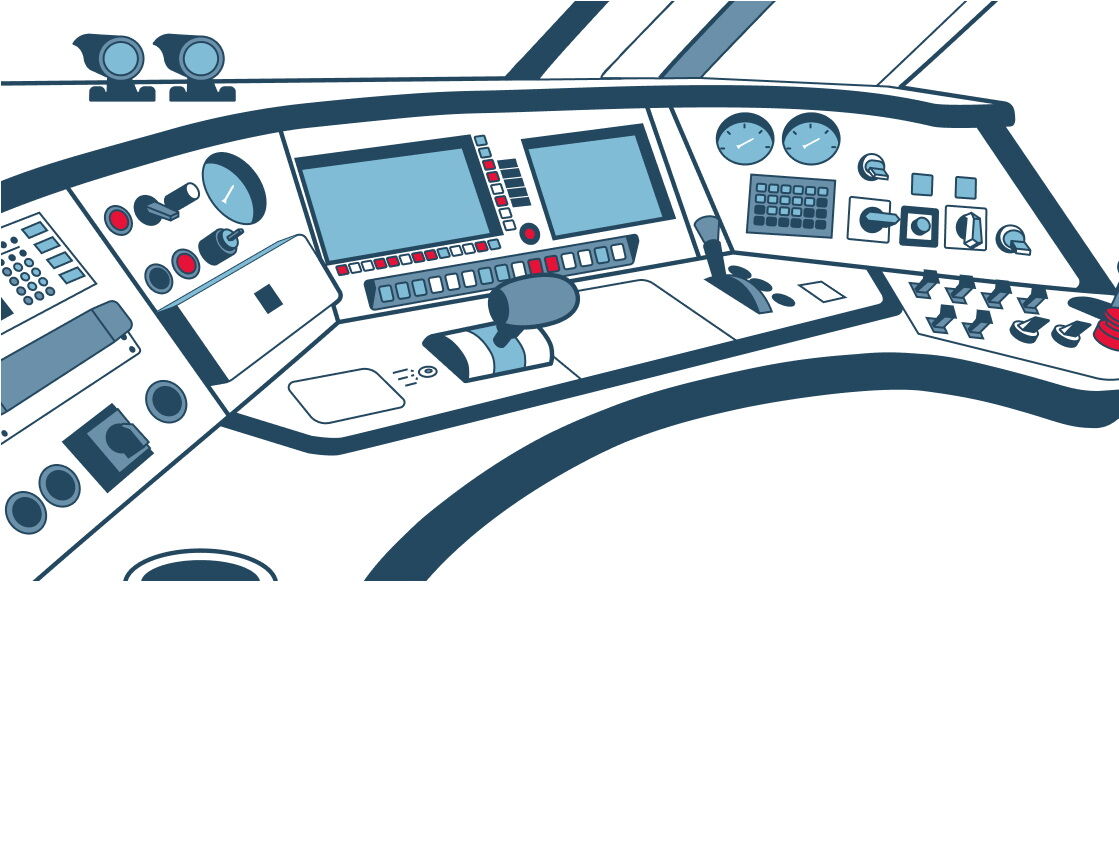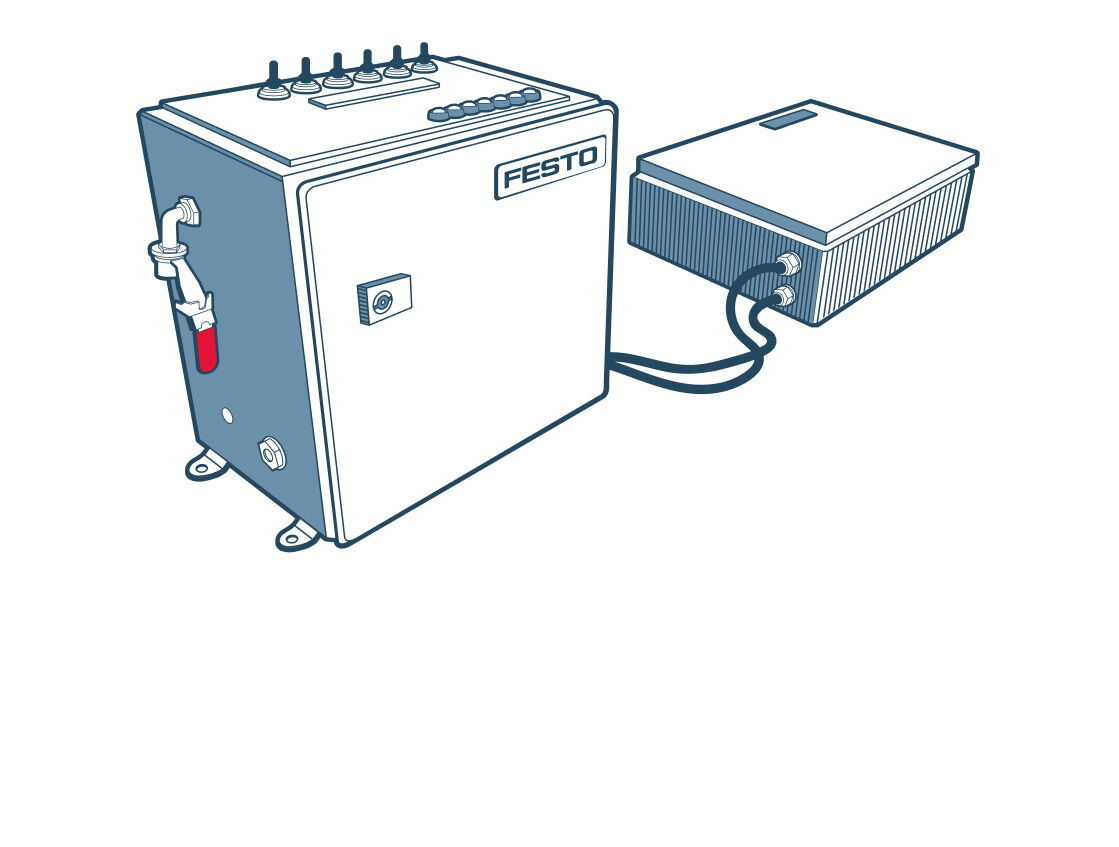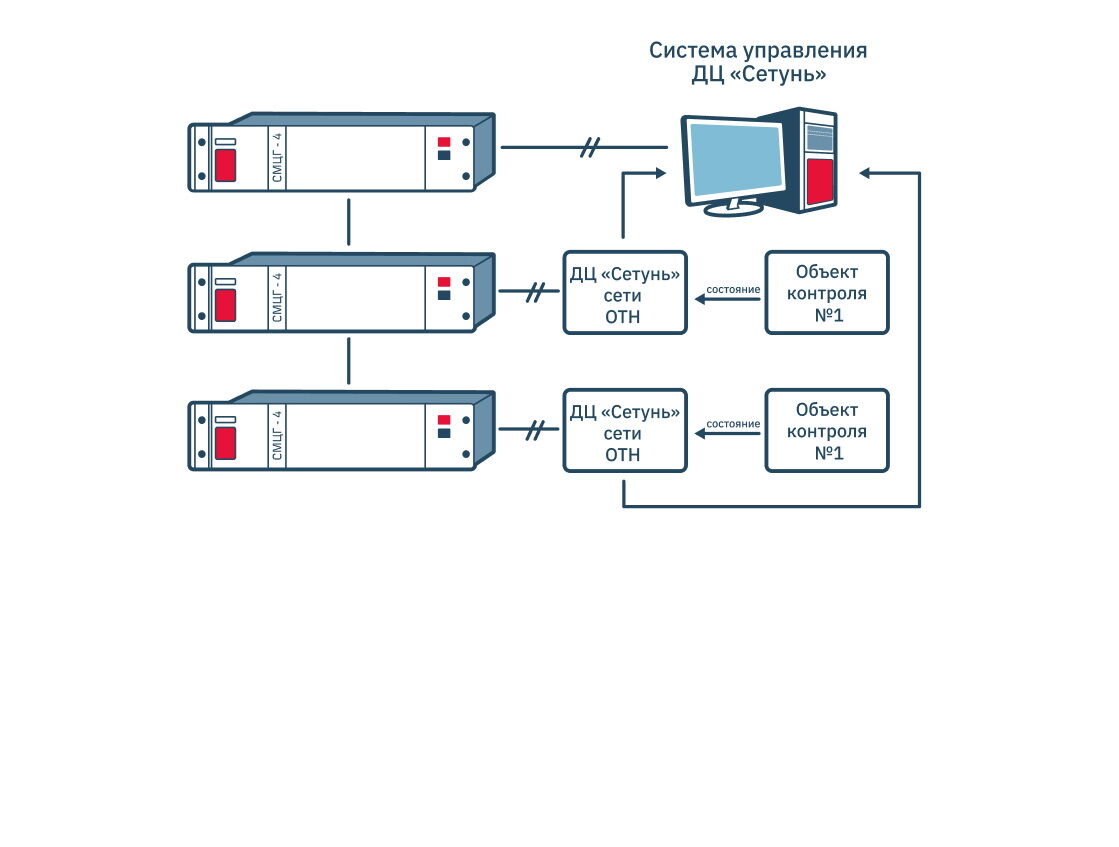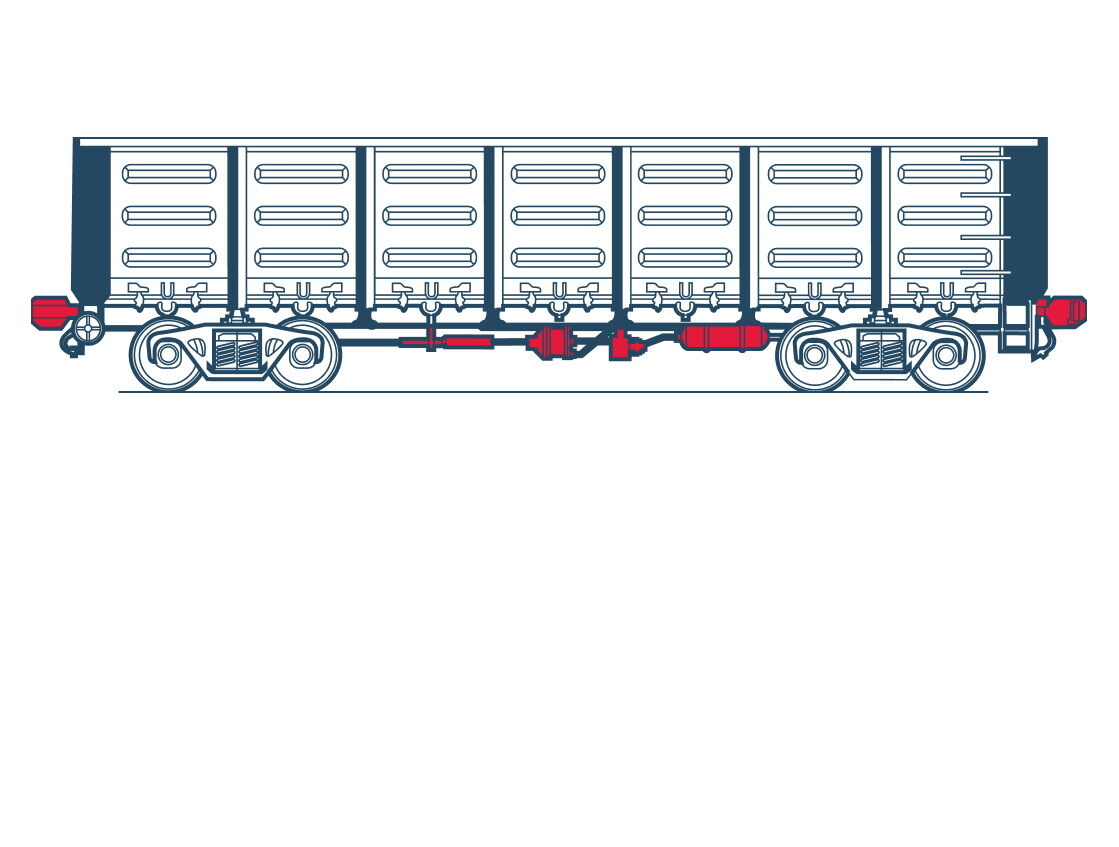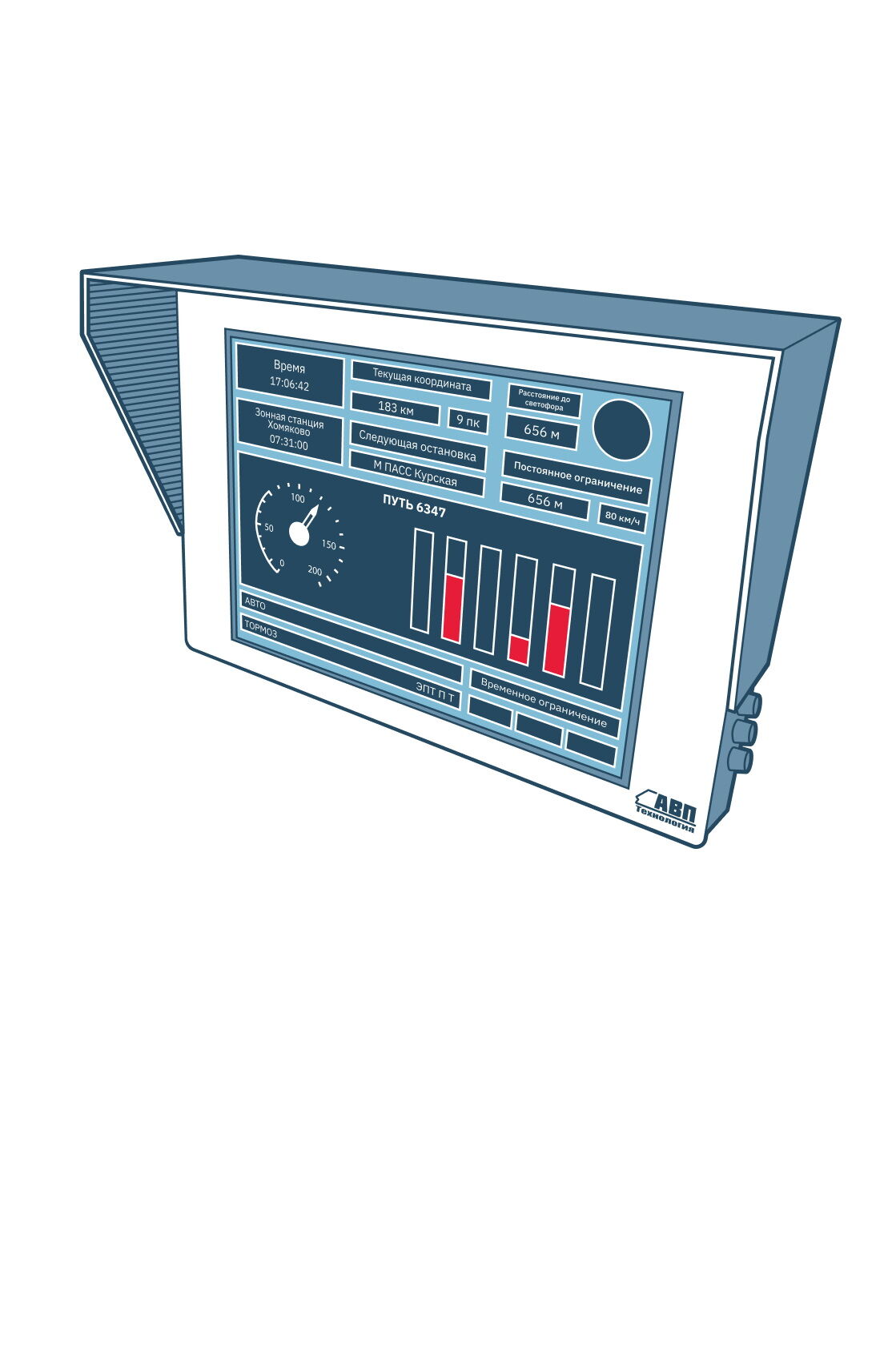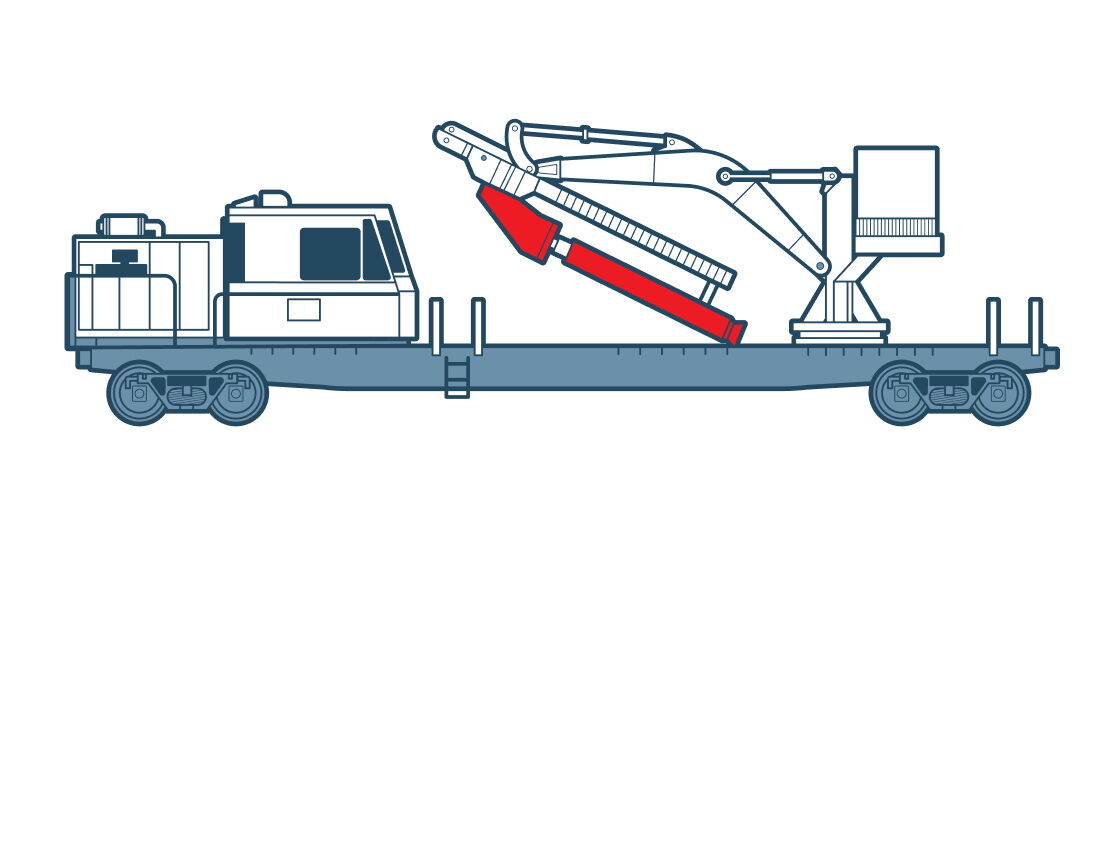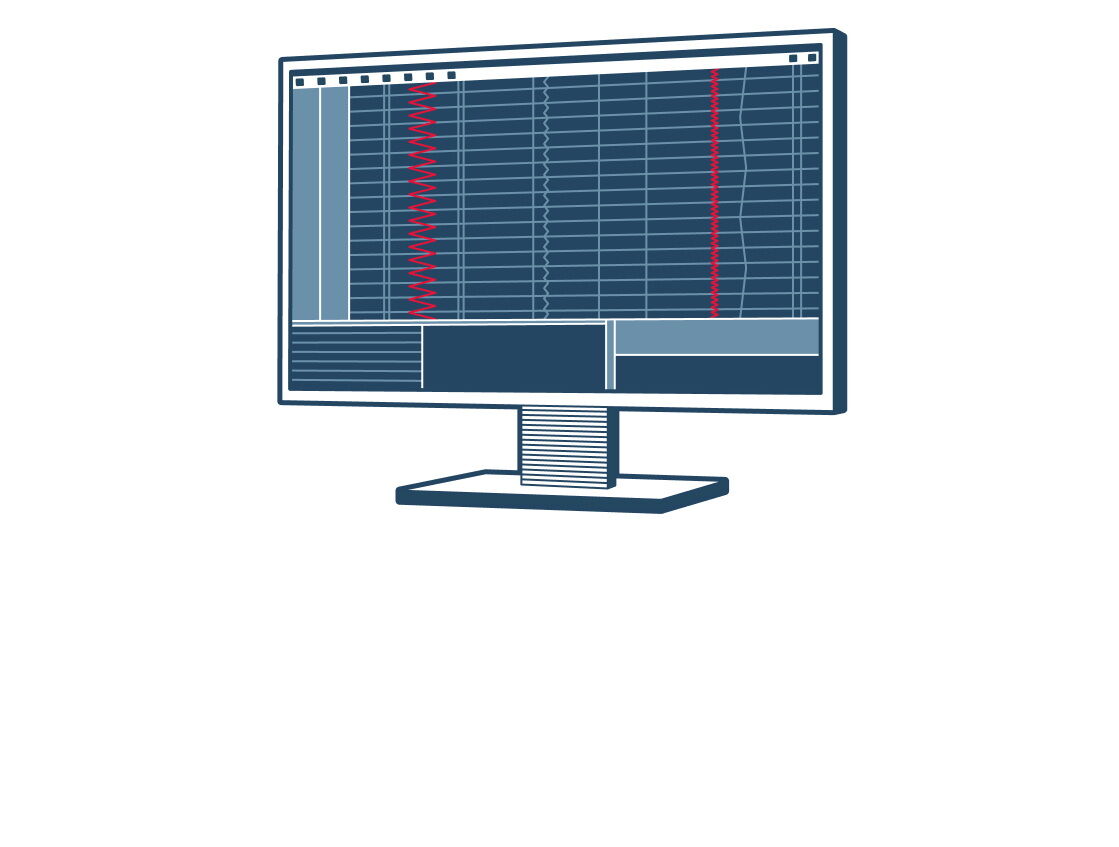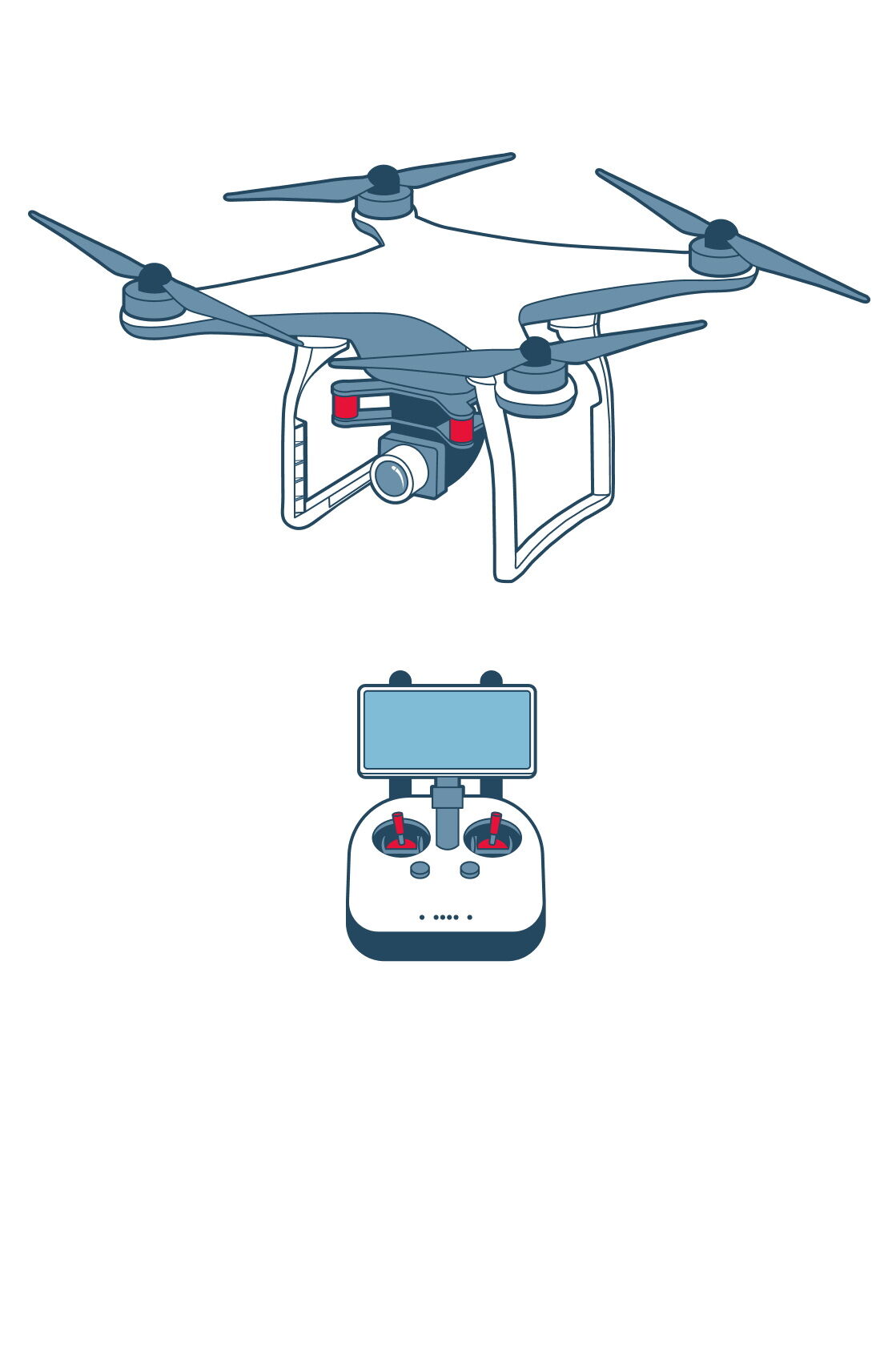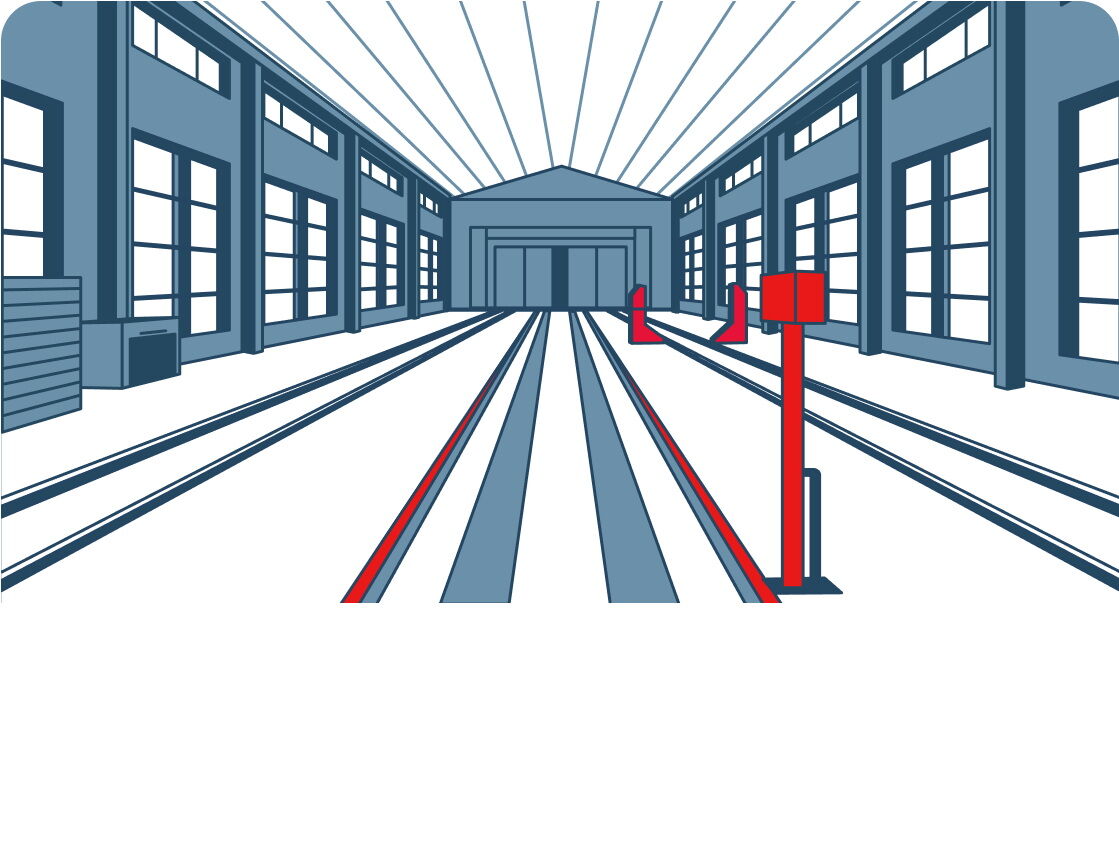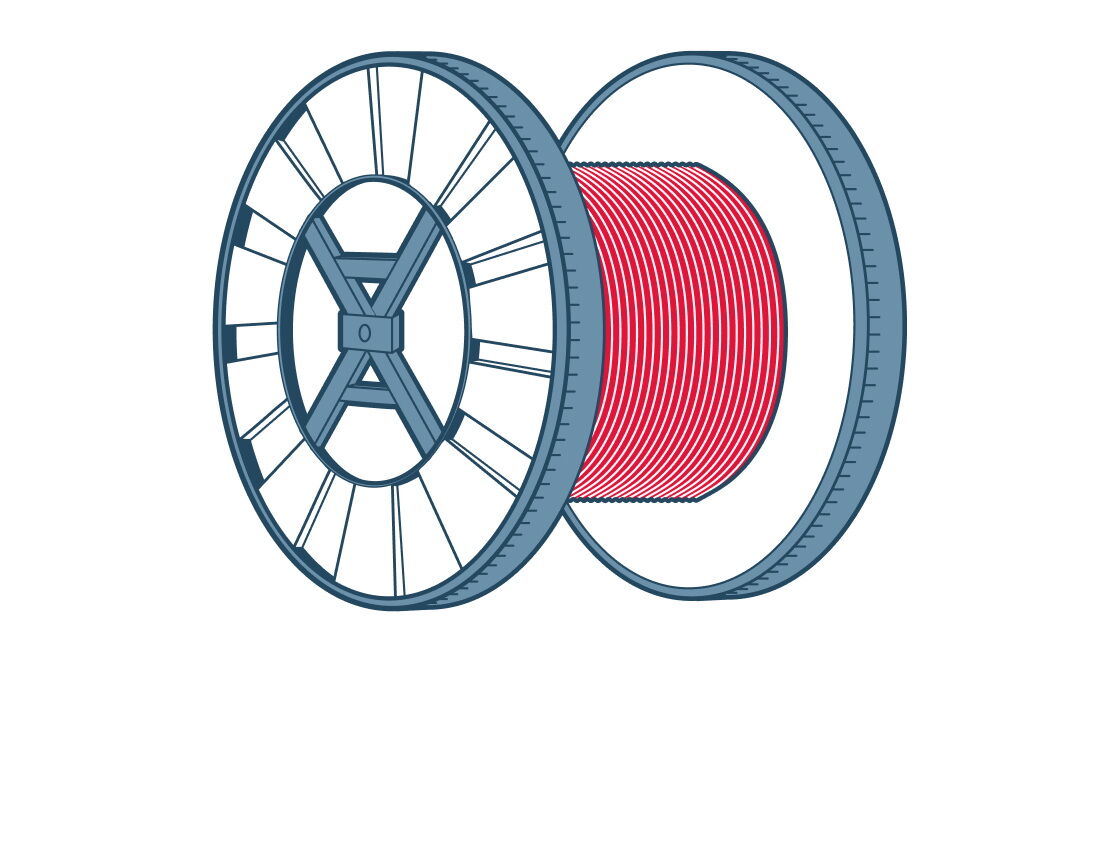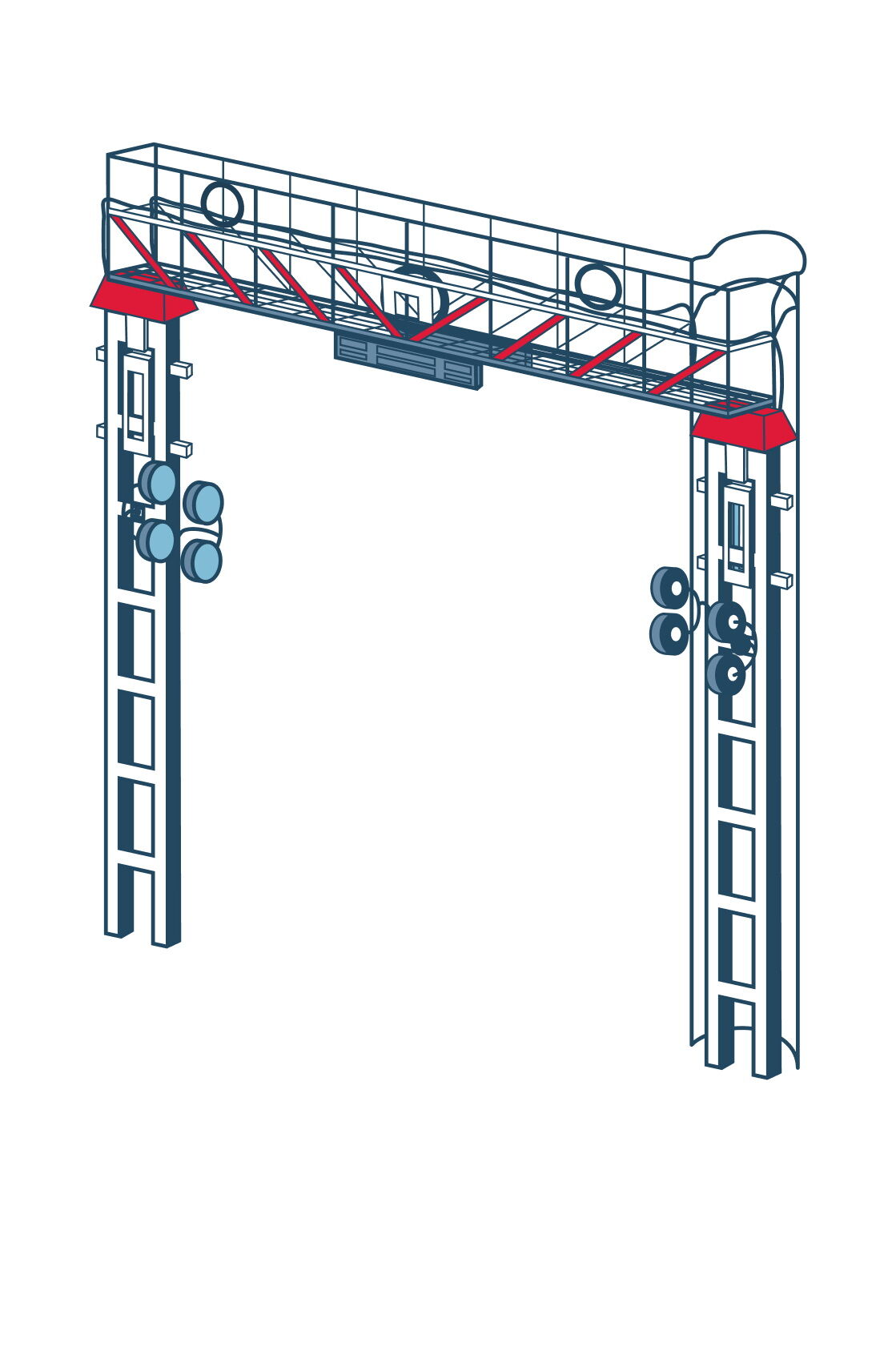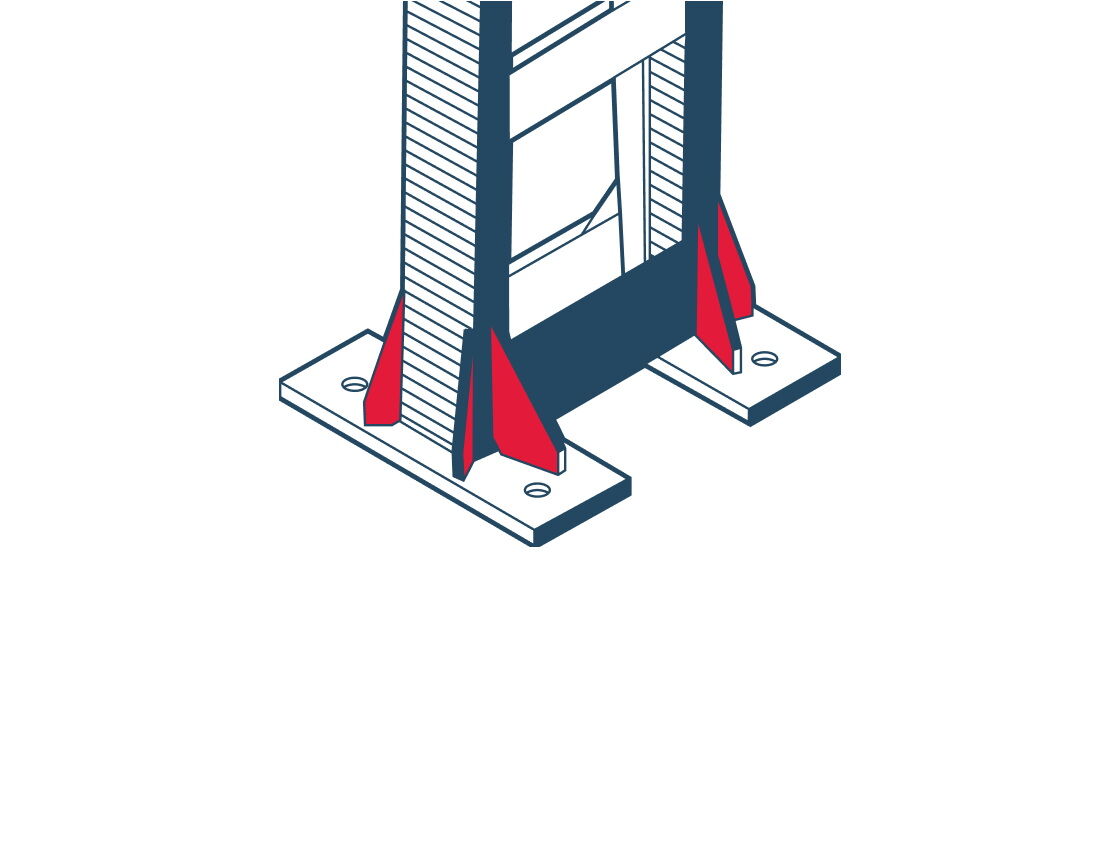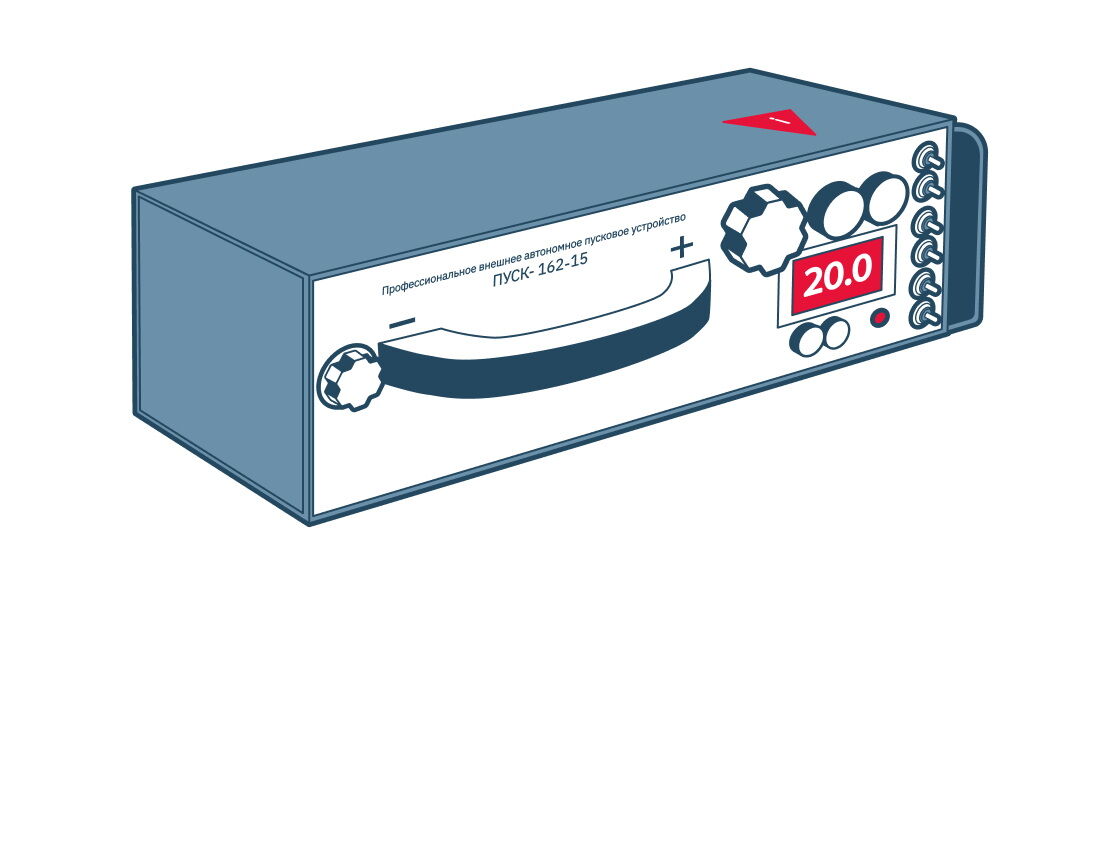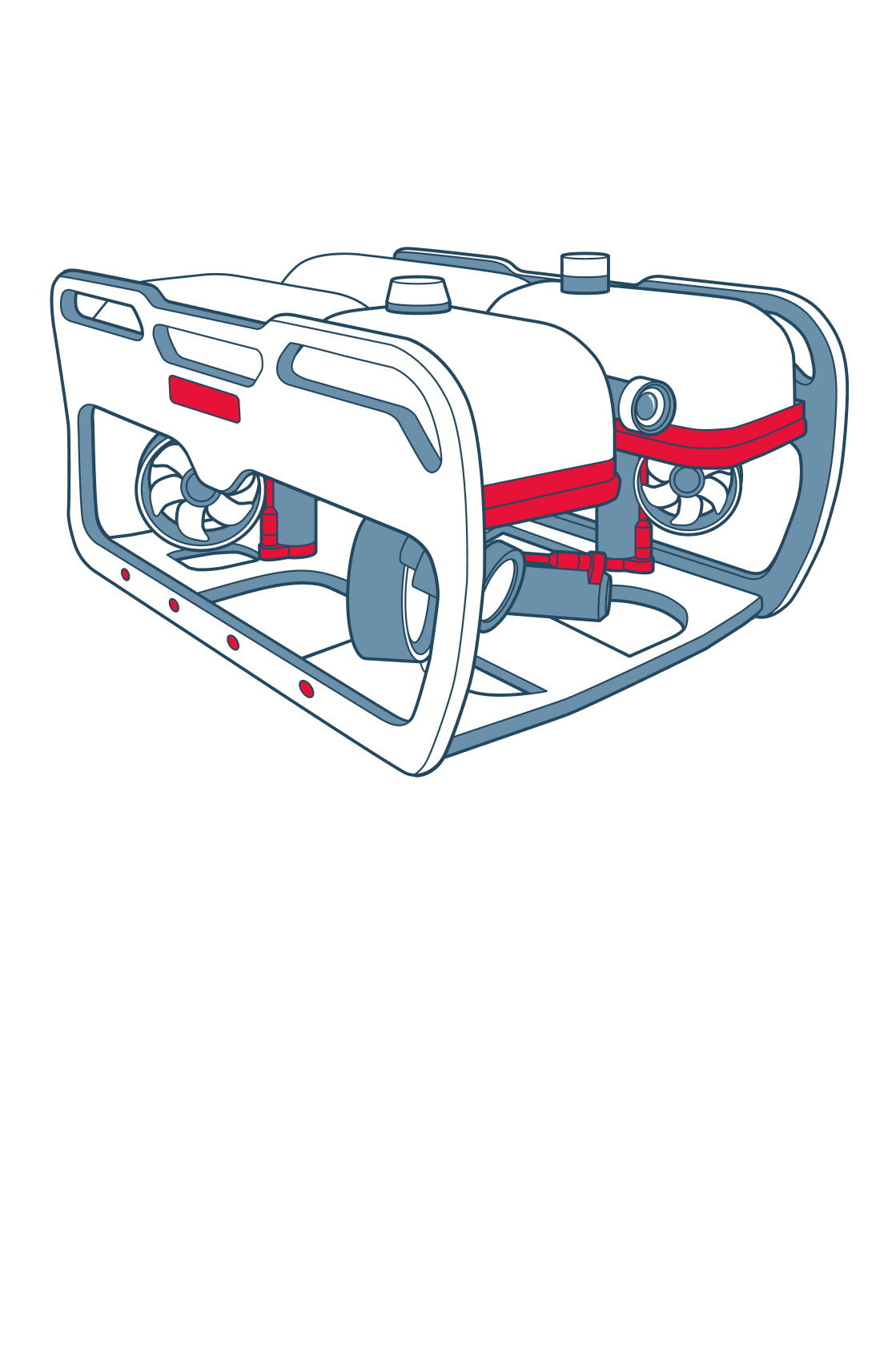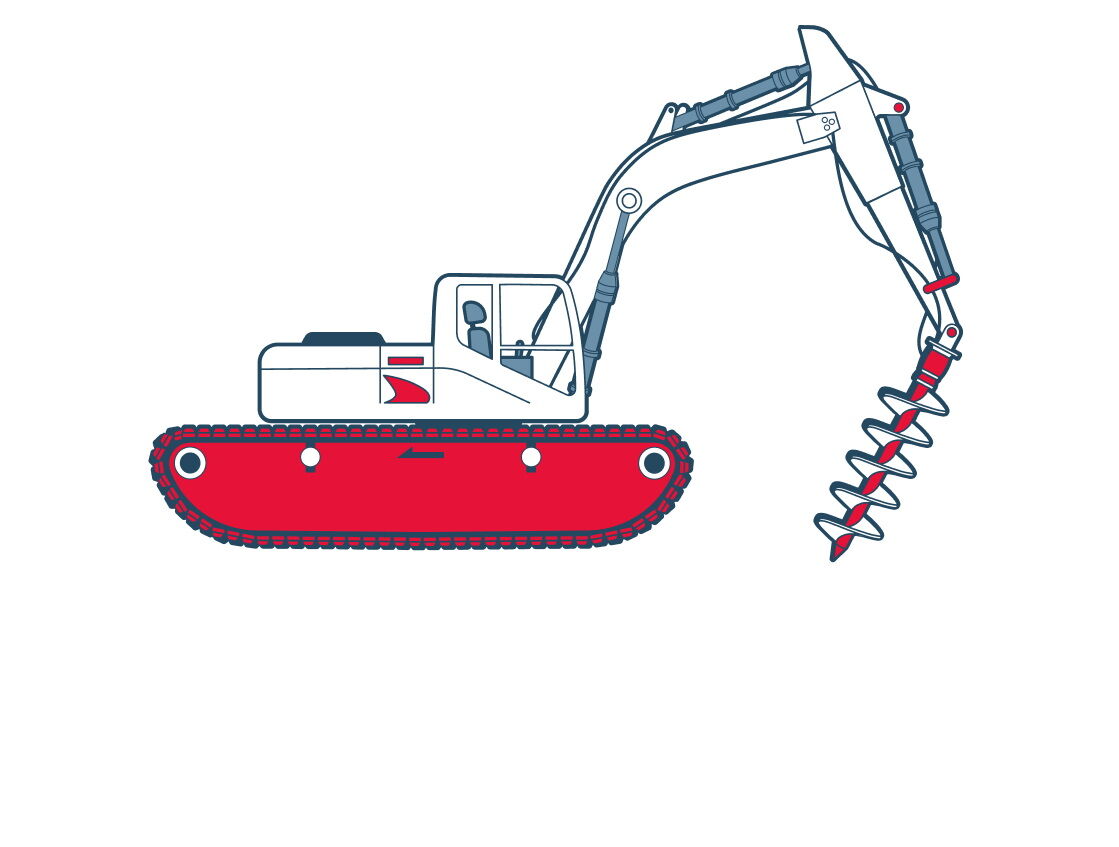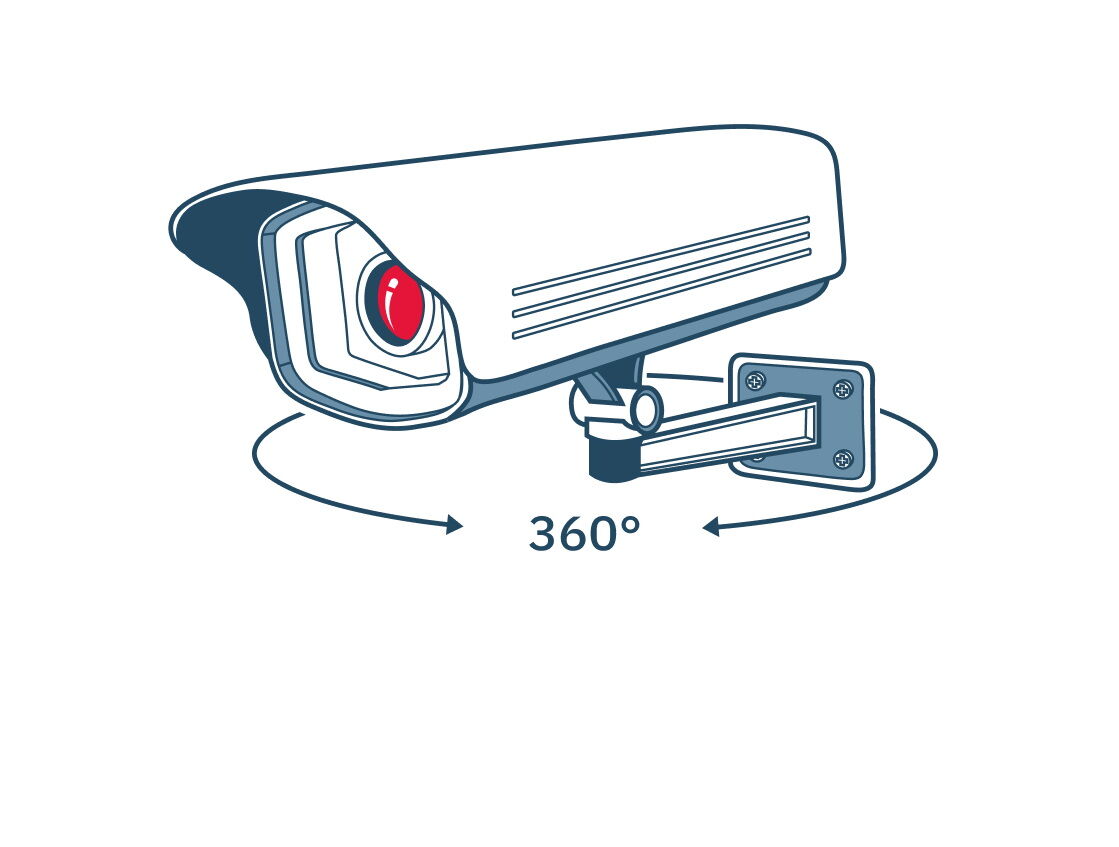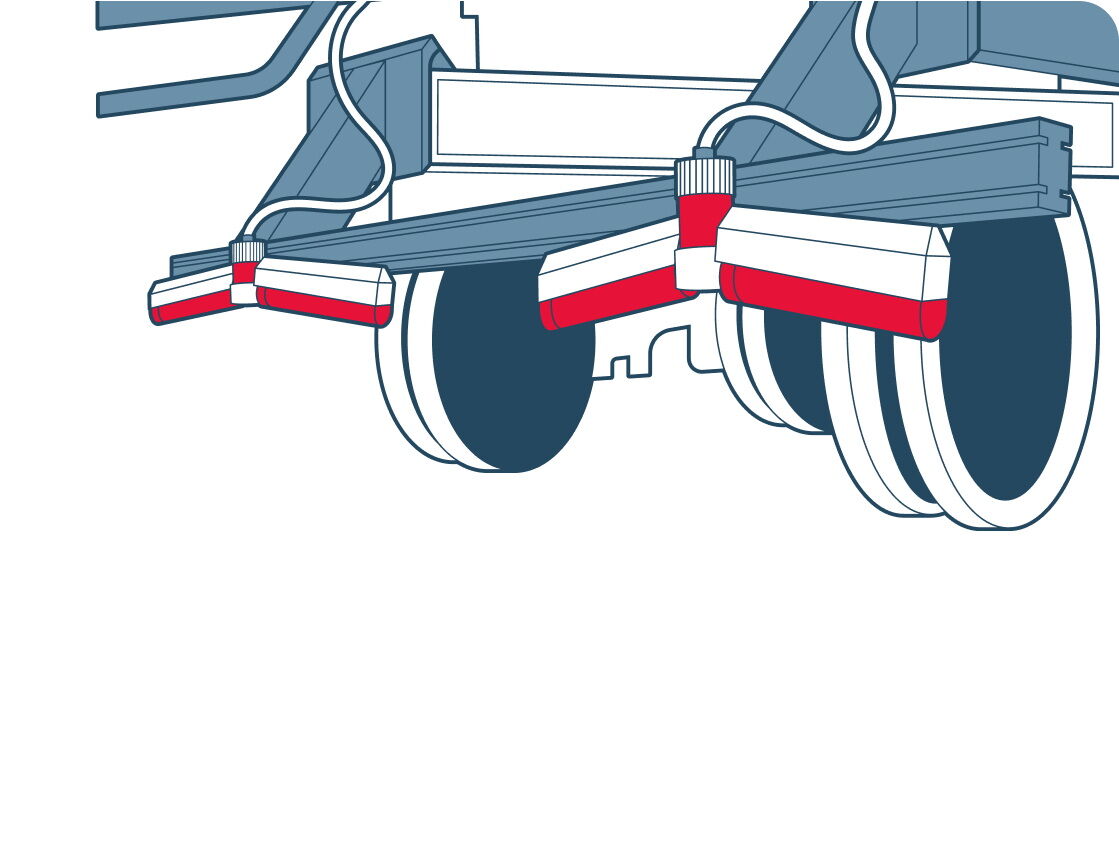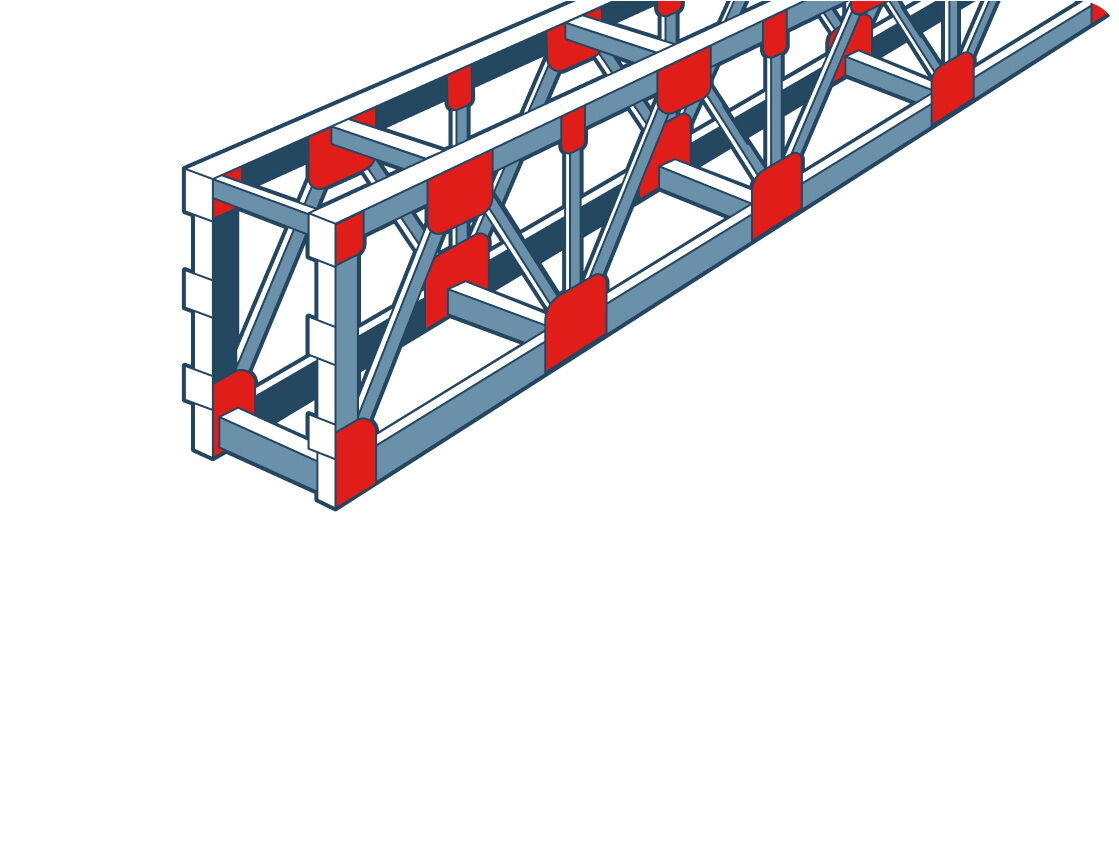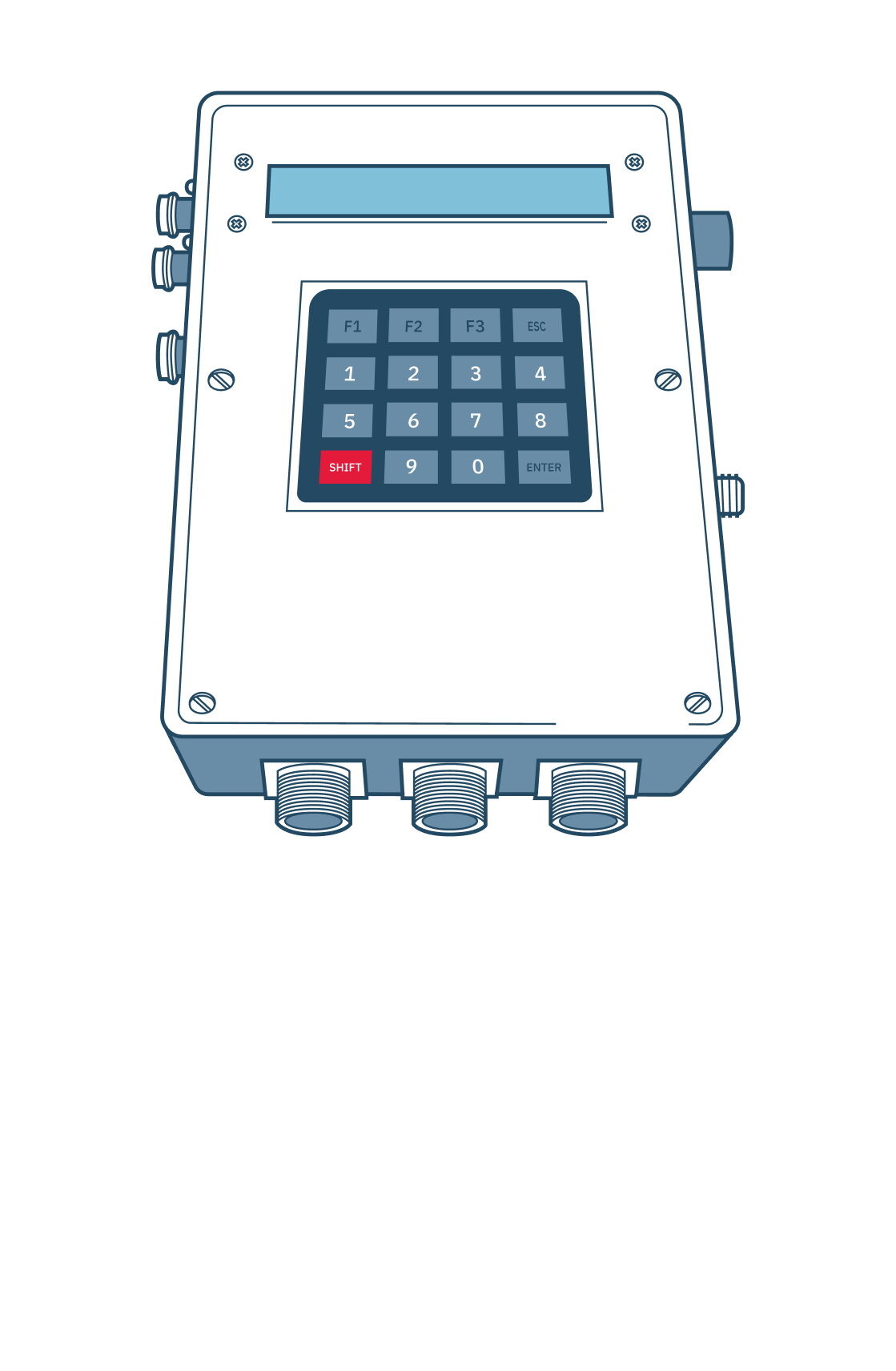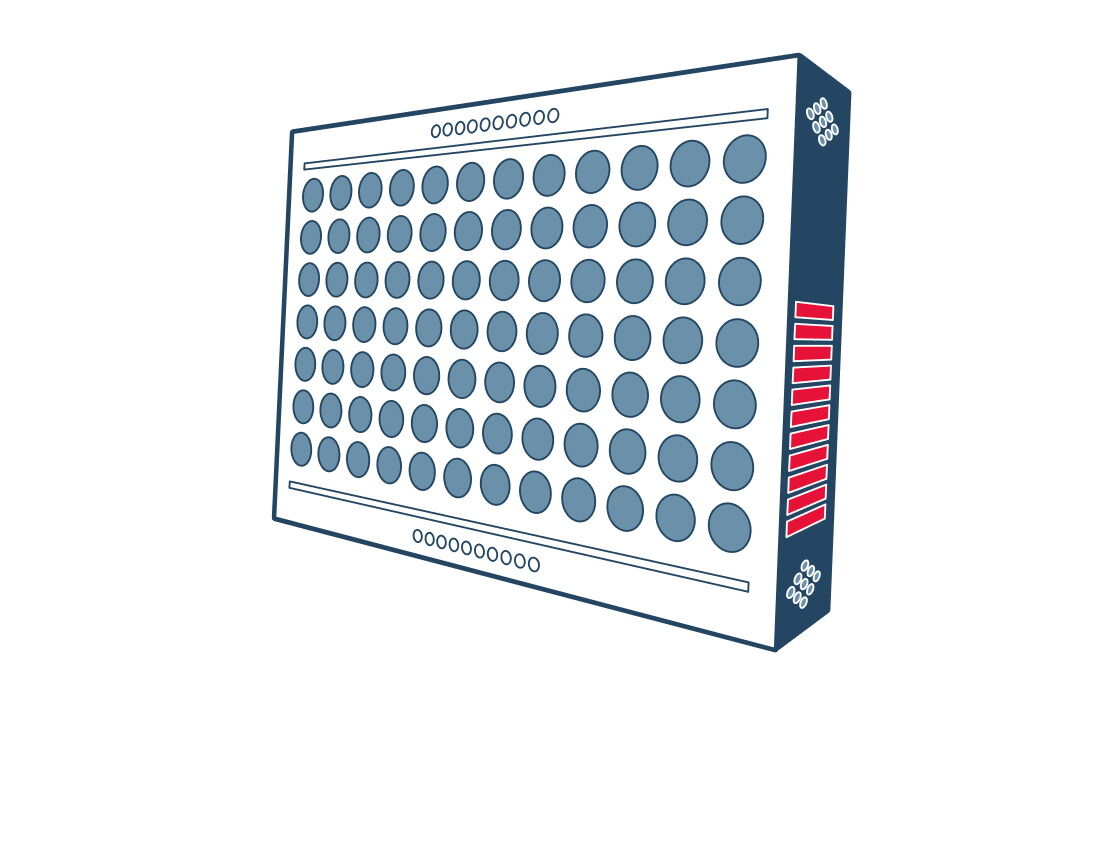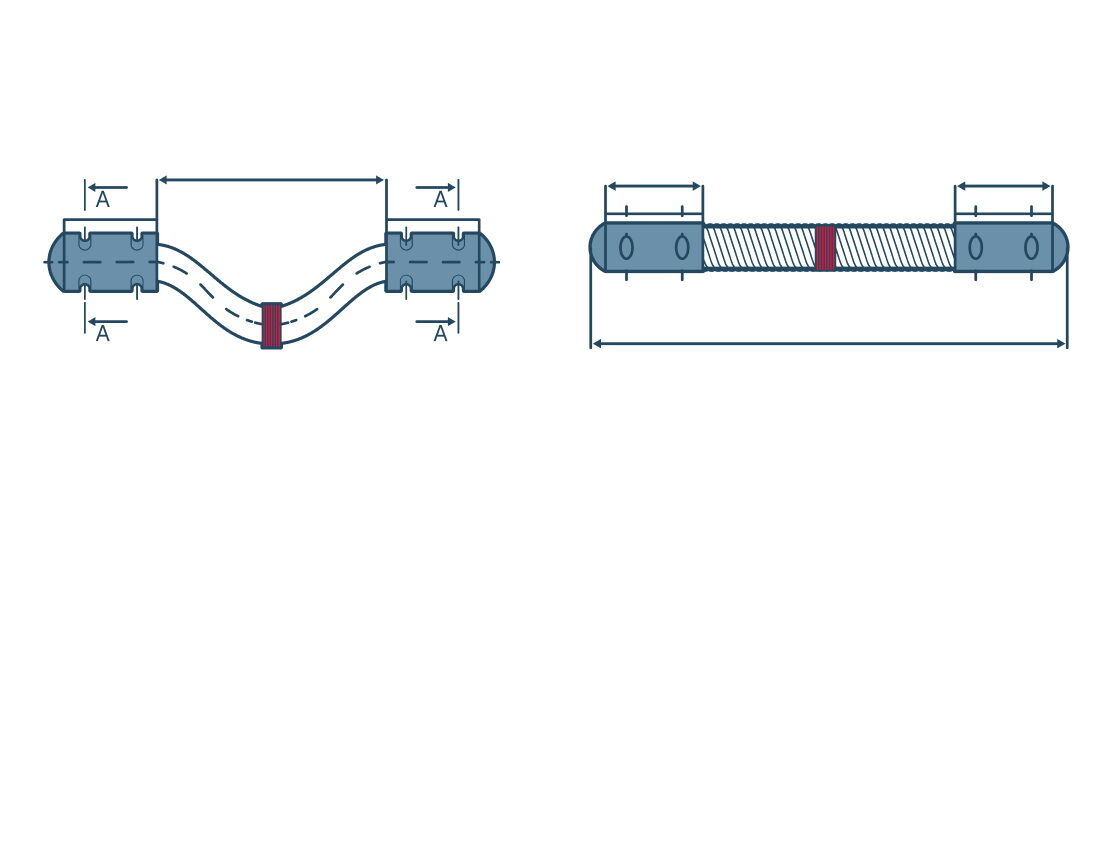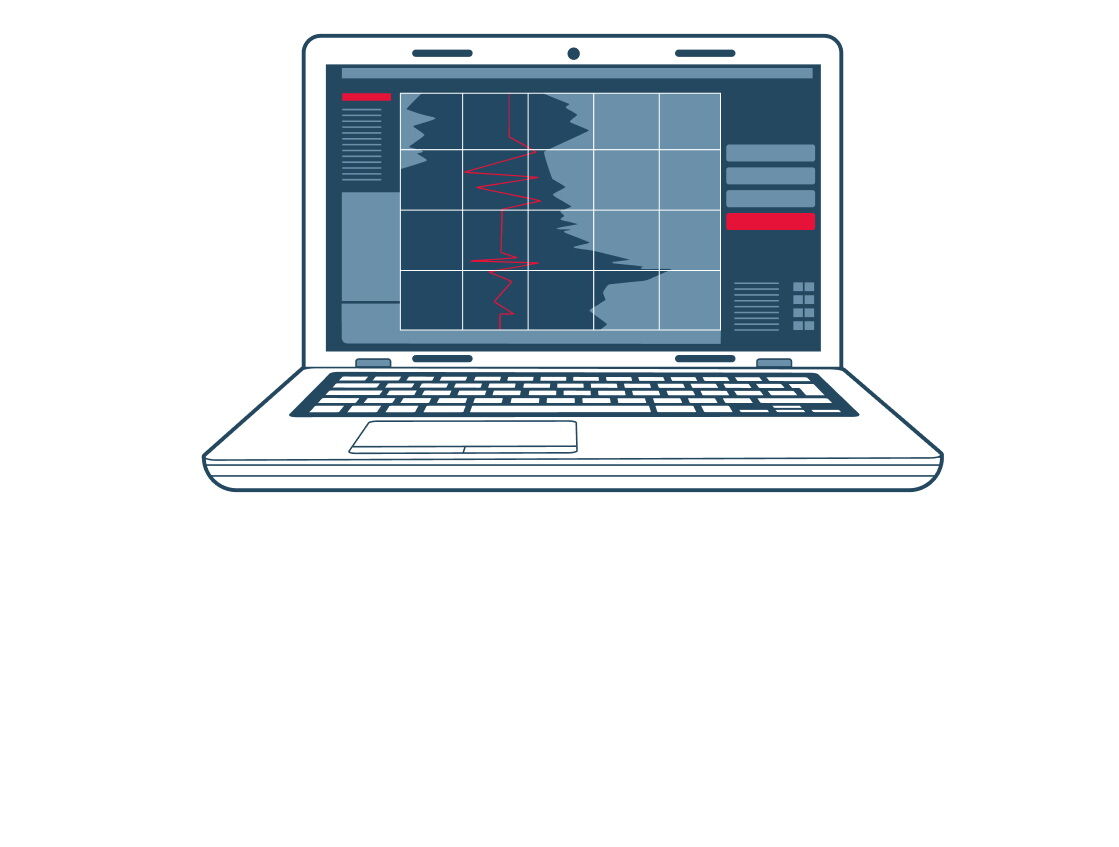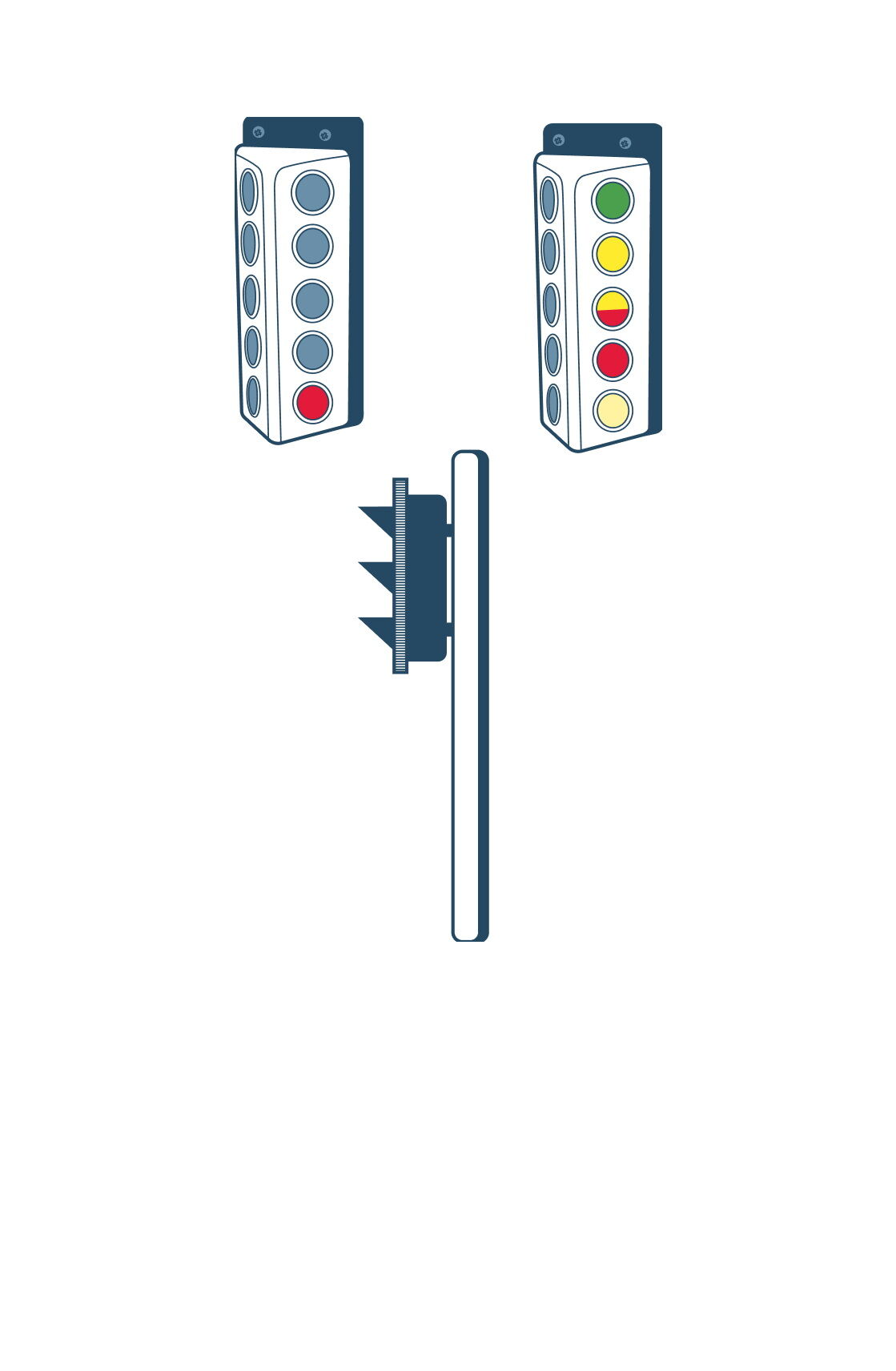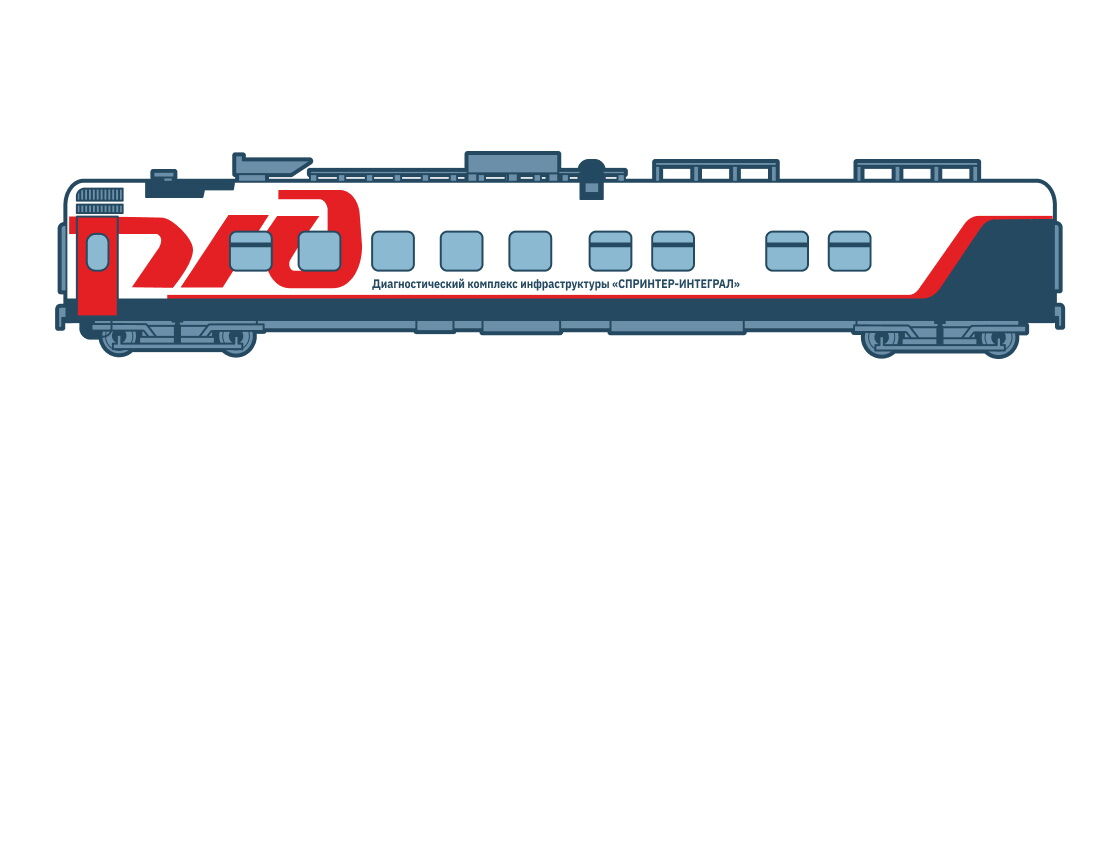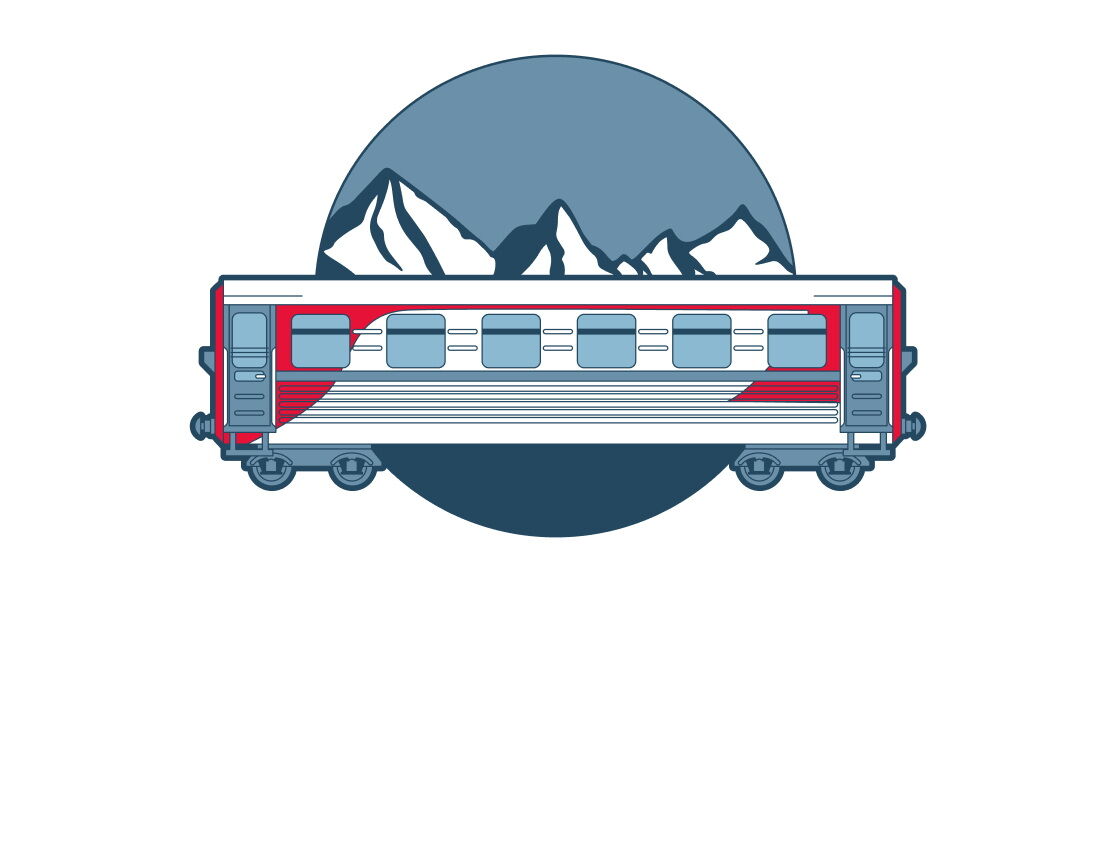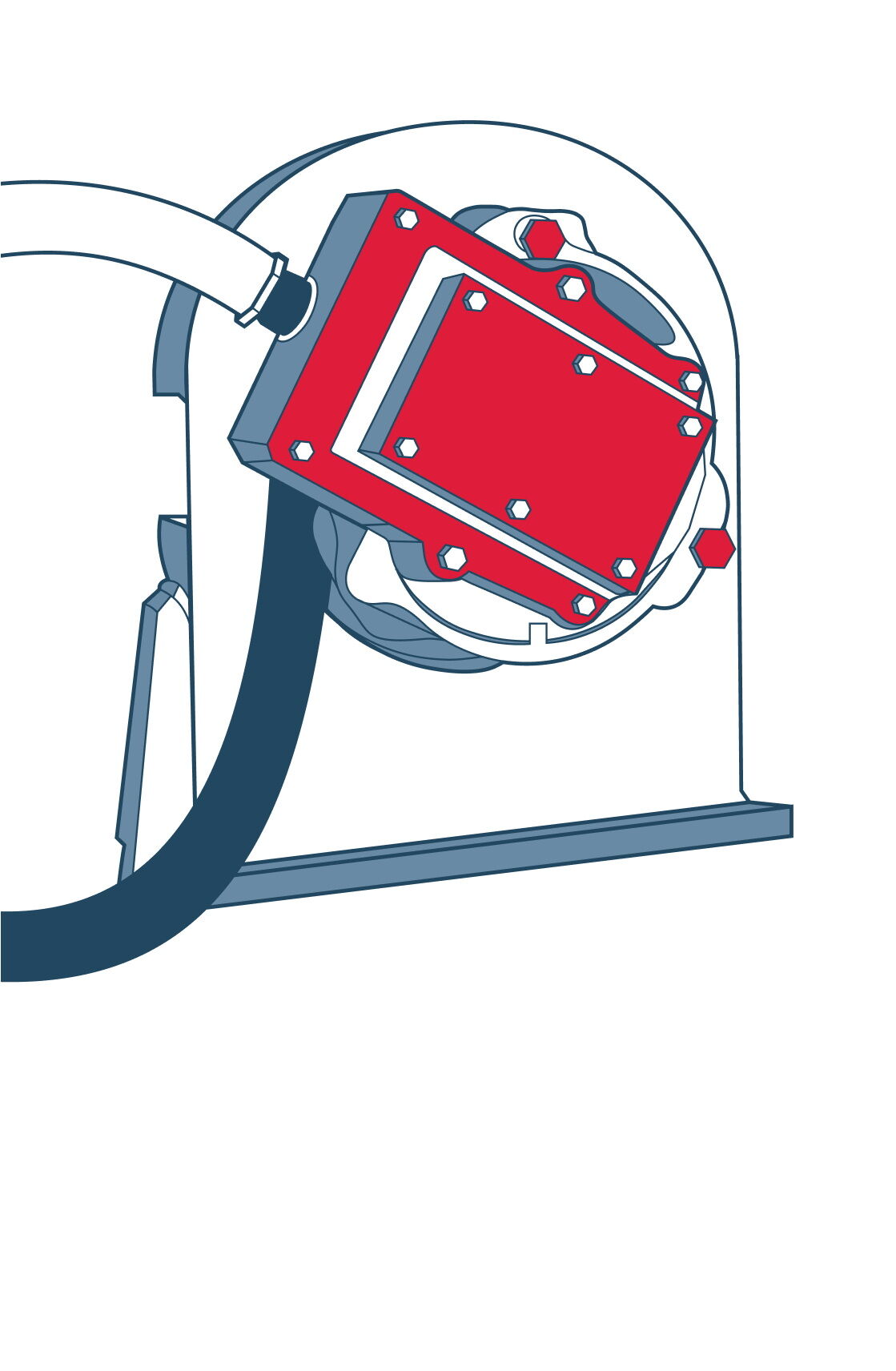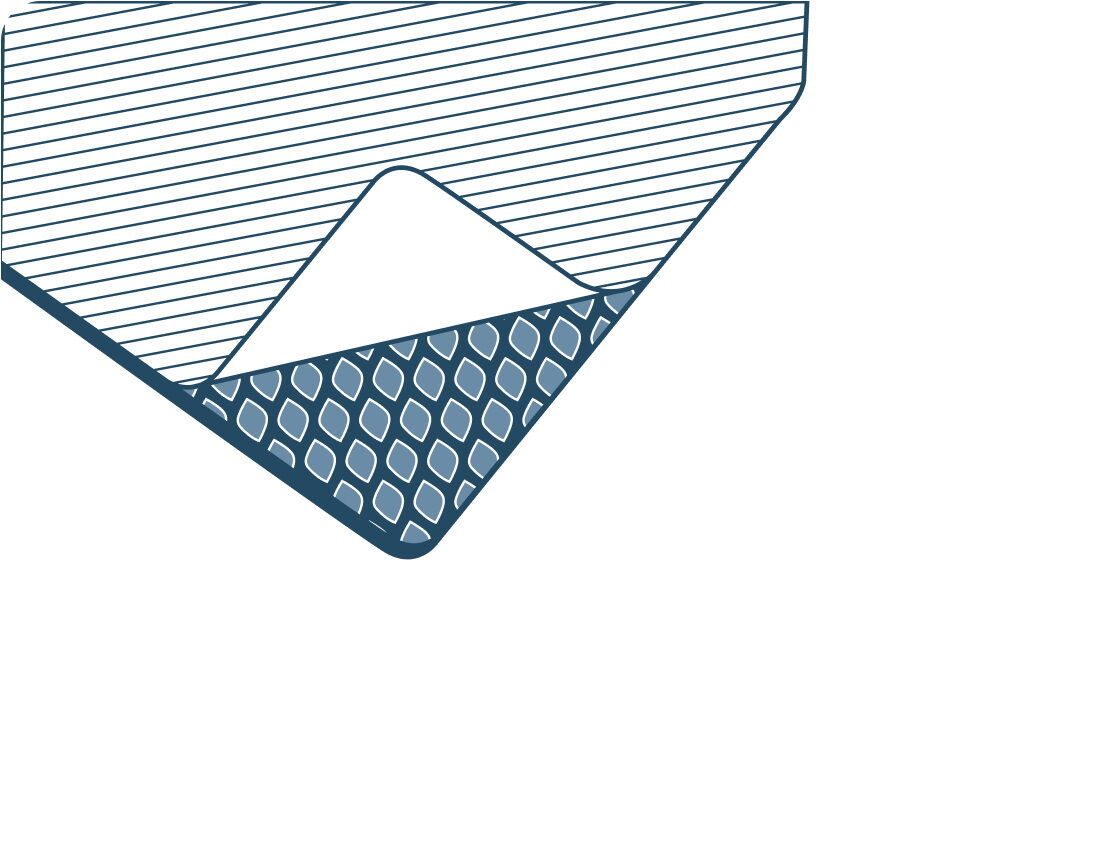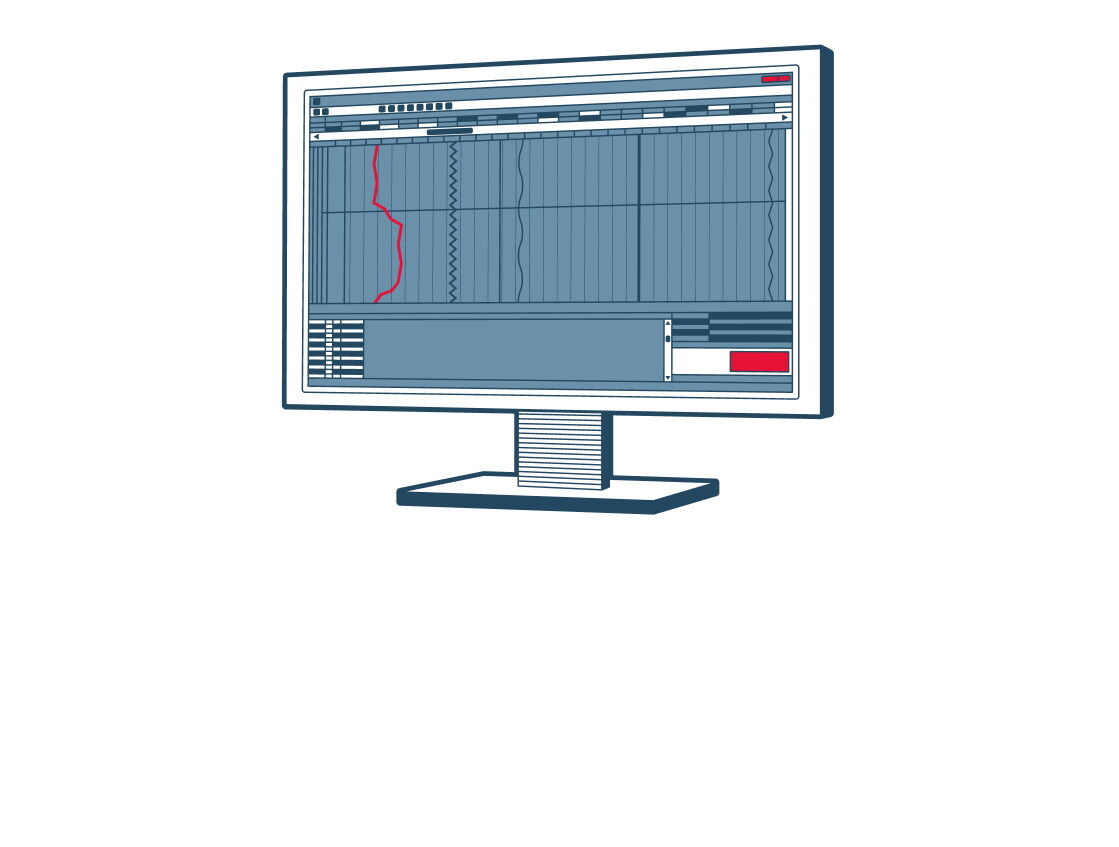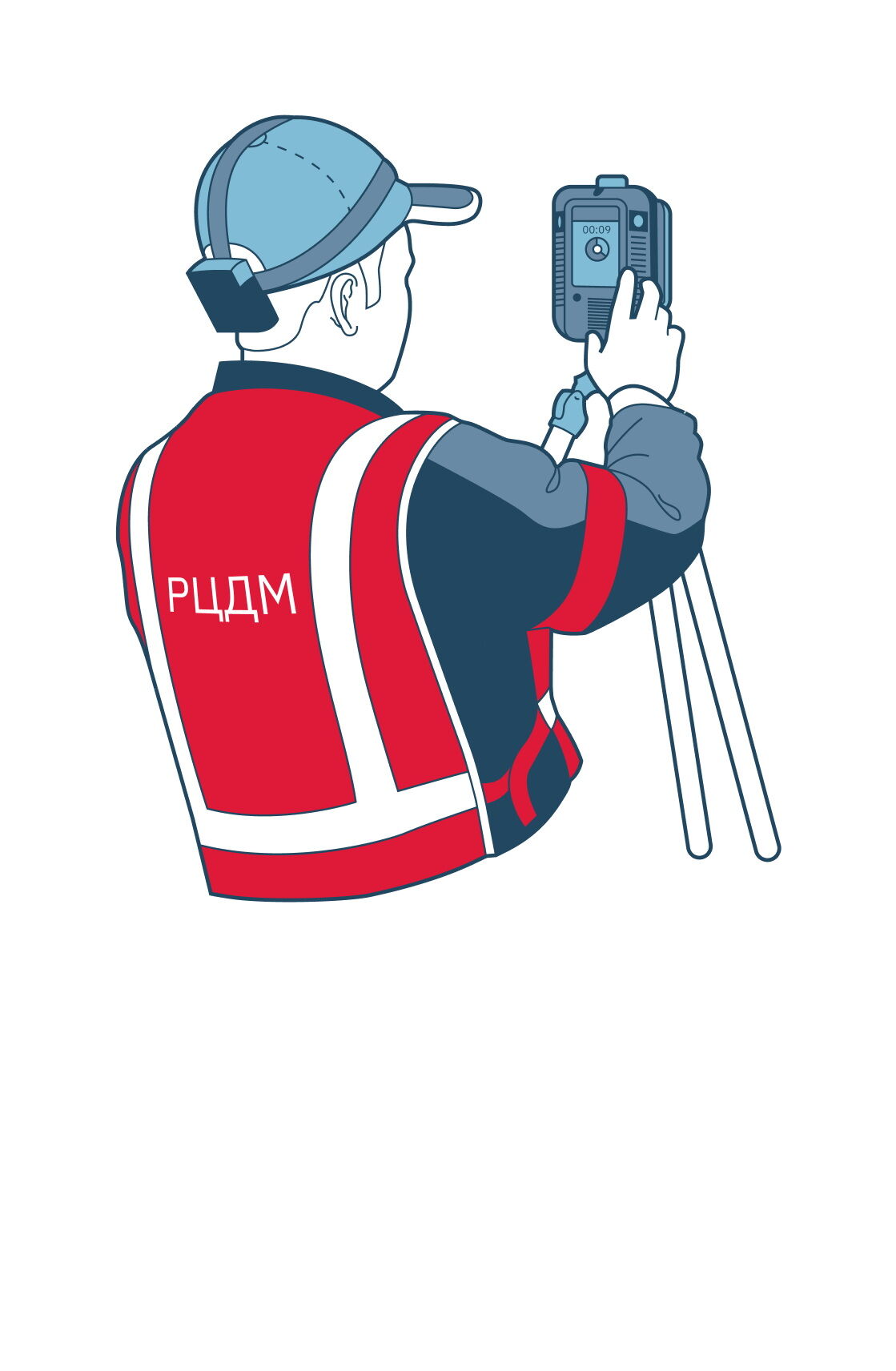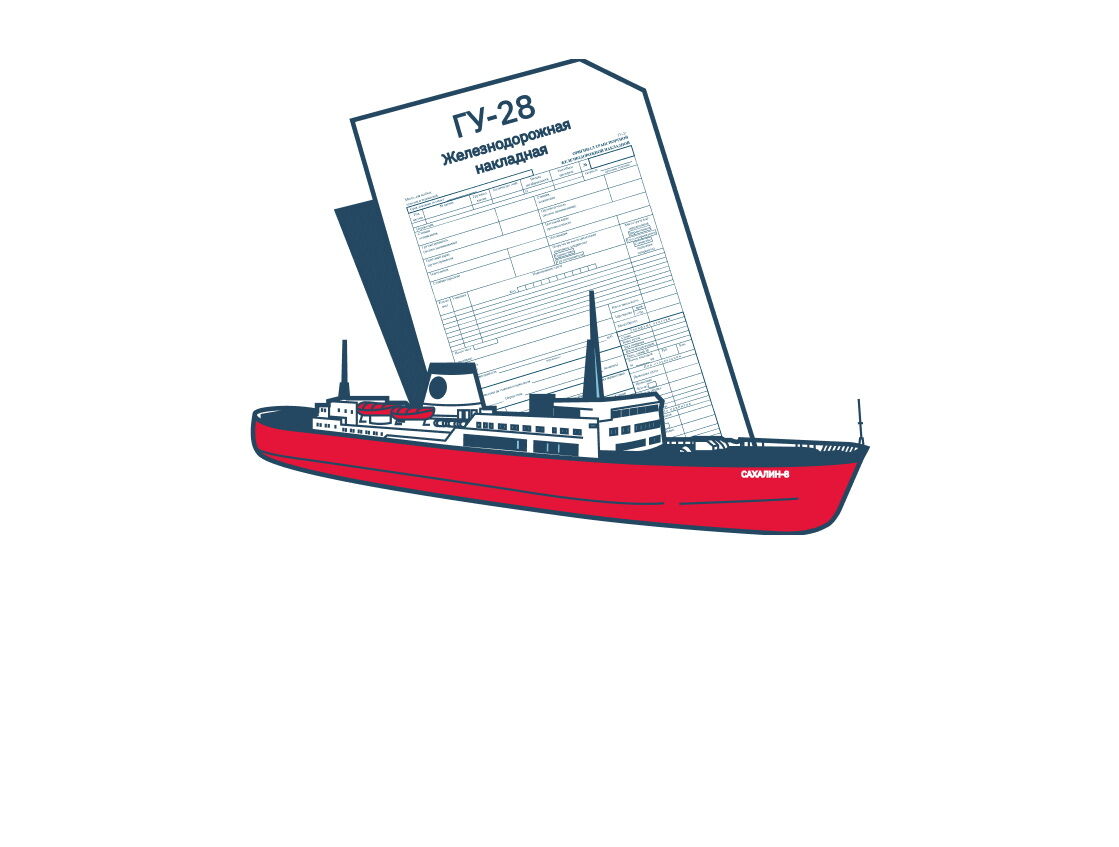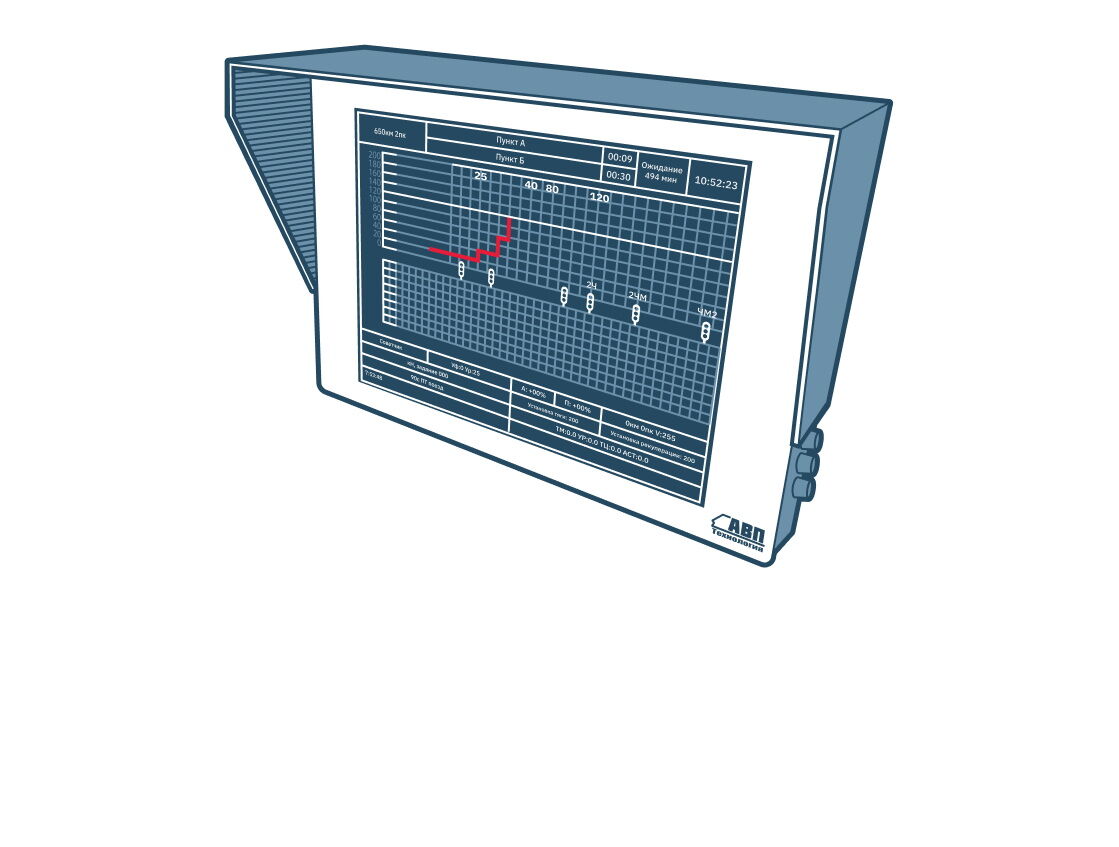Building information modelling
Description of the working principle
The “Second trunk on the Niya—Takovka station-to-station block of the East Siberian Railway” construction project was included in the list of pilot projects using building information modelling.
The Director General and Chairman of the Board of Directors of Russian Railways approved the Roadmap no. 938 of 7 June 2021 for the implementation of pilot projects using building information modelling in the Eastern Polygon.
The Irkutskzheldoproyekt design institute presented an information model for the construction project at the engineering survey stage, at the architectural and construction design implementation stage and an analytical report on the results of the preparation of the design documentation, also in the form of an information model.
The information model was reviewed for adequacy. On the basis of the results of the state expert review, a favourable conclusion was reached. The work execution plan was developed, reviewed and approved.
Construction and installation works are currently ongoing. The commencement of service is planned for 2024.
Rolling stock attachment (locking) device
Description of the working principle
This device is for the attachment of rolling stock on station arrival/departure lines, as well as for stopping and holding moving cars (rolling stock) on marshalling and marshalling-departure lines in order to prevent their unauthorised departure from the marshalling yard or arrival/departure lines.
Effects of implementation
"The use of a pneumatic actuator ensures wide usability of the device in cold climates, as well as ease of installation and maintenance.
The use of reinforced concrete base slabs ensures the durability of the device. It also increases the maintainability of the device by simplifying the replacement of failed braking system component or replacement of the entire device section without dismantling the base."
Key points
The main purpose of the rolling stock attachment device is to improve traffic safety, remove maintenance personnel from the danger zone and eliminate manual labour.
ROIN universal hoist transport equipment (UPTO) multifunctional hydromechanical equipment
Description of the working principle
In 2020, to meet the needs of the Central Directorate for Infrastructure, three units of truck-based and five units of flatcar-based ROIN UPTO multifunctional hydromechanical equipment were delivered within the bounds of the Far Eastern Railway.
In 2022, one unit of flatcar-based and two units of truck-based ROIN UPTO multifunctional hydromechanical equipment were delivered within the bounds of the Transbaikal Railway.
The equipment is designed for use on the Russian Railways track facilities during routine maintenance and major repairs of the railway track and the construction project infrastructure, including programmes to repair the subgrade and bring right-of-way infrastructure directorates up to standard using high-tech equipment, as well as for undertaking lifting, excavating and other works using a wide range of attachments.
Effects of implementation
To determine production efficiency, a comparative analysis to the manual performance of these works shall be undertaken.
1. Clearing of man-made channels
Total annual work plan: 905 m³
In accordance with Technical Standard Sheet no. 7.16 “The clearing of sediment from the channels of small bridges and pipes with soil hauling by wheelbarrow”, the work is completed by two grade II track fitters at a rate of 2.52 man-hours per m³. The rate for the entire scope comes to 905 m³ × 2.52 man-hours = 2,280.6 man-hours, which would require staffing an additional one person.
Labour costs (wages + social tax) for grade II fitters: 2280.6 man-hours × 75.14 rubles + 30.4% (social tax) = 223,459 rubles (excluding any bonus, zonal allowance and hazard pay).
2. Planning, development of drainage ditches
Total annual work plan: 50 m³, or 344,621.7 linear metres.
In accordance with Technical Standard Sheet no. 7.12 “The clearing of intercepting ditches”, the work is completed by a grade II track fitter (one person) at a rate of 0.79 man-hours per linear metre. The rate for the entire scope comes to 344,621.7 linear metres × 0.79 man-hours = 272,251.14 man-hours, which would require staffing the directorate with an additional 138 workers.
Labour costs (wages + social tax) for grade II track fitters: 272,251.14 man-hours × 75.14 rubles + 30.4% (social tax) = 26,675,863.70 rubles (excluding any bonus, zonal allowance and hazard pay).
3. Clearing of crossings from snow and ice
Annual plan: 3,600 m³, 101 crossings
In accordance with Technical Standard Sheet no. 9 “The clearing of crossings from snow and ice”, the work is completed by two grade II track fitters at a rate of 9.82 man-hours per crossing. The rate for the entire scope comes to 9.82 man-hours × 101 crossings = 991.82 man-hours, which would require staffing the directorate with an additional 1 worker.
Labour costs (wages + social tax) for grade II track fitters:
9.82 man-hours × 75.14 rubles + 30.4% (social tax) = 962.19 rubles (excluding any bonus, zonal allowance and hazard pay).
Thus, the labour costs for undertaking this work manually comes to 29.9 million rubles per year. Taking into account the average bonus of 85.4% and hazard pay rate of 4%, labour costs would come to at least 56.6 million rubles per year.
Key points
The following costs would be incurred in the performance of the above works using heavy equipment:
Amortisation of the equipment. With an average useful life of 85 months, annual amortisation charges come to 15.5 million rubles (acquisition cost of 110 million rubles / 85 months × 12 months).
Fuel costs. Average monthly fuel consumption: 6.9 tonnes per 3 units, average cost of diesel fuel: 46,875 rubles per tonne. Fuel costs come to: 6.9 tonnes × 46,875 rubles × 12 months / 1,000,000 = 3.9 million rubles per year.
Labour costs. The additional wage fund to support six workers comes to 4.7 million rubles per year. The social tax contribution of 30.4% comes to 1.4 million rubles. Other labour costs (national pension fund, voluntary health insurance, social benefits, etc.) come to 0.5 million rubles.
Materials. Costs for special clothing for workers and maintenance of equipment come to 0.4 million rubles.
Other expenses. Costs for medical examinations, property insurance and travelling expenses come to 0.8 million rubles.
Total costs come to: 15.5 + 3.9 + 4.7 + 1.4 + 0.5 + 0.4 + 0.8 = 27.2 million rubles.
Minimum economic benefit: 56.6 − 27.2 = 29.4 million rubles.
One set of equipment includes:
Universal hoist transport equipment (UPTO): 1 unit
Special attachment equipment:
sleeper lifter: 1 unit
rail lifter: 1 unit
bucket grab for snow: 1 unit
bucket grab for removal of ballast from sleeper spaces and sleeper changeover: 1 unit
V-ditch bucket: 1 unit
digging bucket: 1 unit
grading bucket: 1 unit
clamshell bucket (with teeth): 1 unit
high hit frequency hydraulic breaker: 1 unit
mulcher: 1 unit
hook suspension: 1 unit
hydraulic lifter: 1 unit
concrete mixer: 1 unit
crane man basket: 1 unit.
SPB-02 testing bench
Description of the working principle
The SPB-02 testing bench is designed for automated performance testing and fault detection during maintenance and repair works on automatic train operation and locomotive movement parameter recording systems. The testing bench is an electronic device comprising a personal computer with special software. The electronic units of the automatic train operation and parameter recording systems being tested are individually connected to the bench using a cable set integrated into the bench and are performance tested.
Effects of implementation
Automatic testing of electronic unit performance and compliance with the parameters of mandatory technical specifications (power consumption, generated output voltage, measurement channel impedance, etc.).
Testing of all communication interfaces integrated in the tested equipment (CAN, RS-485, etc.). The bench simulates the external devices that the units exchange data with in manual mode, and performs a step-by-step check of the electronic units’ performance.
Key points
The bench enables unit microcontrollers to be programmed using built-in programmers via CAN and BDM interfaces and also generates reports containing the test results and saves these reports to storage media (computer hard drive, printer, etc.).
Universal pneumatic pressure car retarder
Description of the working principle
Intended for use on tangent track sections of hump retarder and brake stop positions of in-operation, in-development and newly built automatic and mechanical marshalling yard humps. Many years of experience with retarders and the recommendations of marshalling yard operating personnel were taken into account during development. As a result, the universal pneumatic pressure car retarder incorporates all cutting-edge technical innovations and is the most advanced retarder in the Russian Federation and beyond.
Effects of implementation
The design of the car retarder allows free passage of diesel locomotives of any specification.
The use of reinforced concrete base slabs ensures the durability of the structure. The maintainability of the retarder is increased by the simplification of the replacement of failed retarder system components or the entire retarder unit as a whole without dismantling the base.
The easy-to-remove protective cover prevents negative external environmental influences and eliminates accidental contact between workers and the moving components of the retarder, which increases safety and reduces injuries.
A blower system makes it much easier to clear snow from the retarder in the winter period.
Unlubricated components facilitate the periodic maintenance of the retarder.
The design of the levers and their arrangement along the length of the retarder ensures uniform distribution of the braking force, increasing the braking power with a significant reduction in noise level.
The braking bar wear warning system makes it easier to monitor critical wear during set-up and adjustment.
ISAVP-RT-M virtual coupling (modernised smart system for automated driving of coupled trains with length-distributed traction)
Description of the working principle
When driving trains using virtual coupling, locomotives are linked up via radio and continuous data exchange takes place (location, length, weight, current and future operating mode). The slaved locomotive, which follows in the same direction, processes the data from the lead locomotive and selects the optimum operating mode.
Based on the data from the lead locomotive, the slaved train’s upgraded USAVP system with ISAVP-RT-M system installed calculates the moment the locomotive light signal changes from yellow to green or from red-yellow to yellow, thus maintaining the shortest safe distance between the lead and slaved trains without applying the brakes or exceeding the speeds set by the safety device. In order to calculate the optimal trajectory of the lead train, the effectiveness of the braking system of both the lead and the virtually coupled train is continuously calculated.
Effects of implementation
Improvement of traffic safety.
15% increase of carrying capacity of existing infrastructure.
Possible traffic interval between freight trains from 7 minutes.
Reduction of locomotive fleet turnover by 20%.
Key points
Organisation of packets of up to 5 locomotives using virtual coupling.
Organisation of radio exchange networks within locomotive packets using virtual coupling via built-in satellite navigation signal receivers.
Driving of packets inside the “window” working period.
Detection of pre-failure conditions of units on board locomotives.
Increase in locomotive availability factor without additional departure diagnostics due to the creation of statistically significant bodies of data regarding locomotive operation.
Improvement of journey power supply due to accumulated track-indexed data regarding catenary and locomotive power consumption.
Digital transceiver (Far Eastern Territorial Centre for Corporate Transportation Services)
Description of the working principle
In 2023, as part of the measures for the export of containers from the Far East, the Far Eastern Territorial Centre for Corporate Transportation Services proposed the implementation of digital transceiver technology for the receipt of container-loaded open top cars for carriage.
Effects of implementation
In the period from 18 January to 30 June 2023, the above consignor loaded 10,933 cars with containers and accepted 8,084 cars for carriage using this technology, which amounts to 74% of the total number of loaded cars.
Key points
The project was included in the list of innovations proposed for implementation in the Far Eastern polygon of the railway in 2023 requiring the establishment of experimental regulatory procedures in accordance with Russian Railways order no. 2844 of 1 November 2022.
The newest unified control console (UPU-4)
Description of the working principle
From the outset, the development concept of the driver unified control console harnessed the principle of open architecture, with the ability to connect the electric train’s console apparatus to existing and future control, diagnostic and safety systems via software. Even today, the software can still be modified and the electric train—driver dialogue interface video frames aligned, enabling the integration of practically any digital system into the system.
Effects of implementation
Can be used in various types of motor car rolling stock and locomotives.
Consists of modular components, allowing for quick repairs by swapping out modules.
The unified control unit contains all components necessary for control and diagnostics of train systems and transport safety systems (video surveillance system, fire alarm system, passenger information system and passenger traffic flow counting system).
All systems of the unit are closely integrated into the central computer, making it possible to implement complex interrelated algorithms for train control and diagnostics.
The workstation has a modular design, enabling it to be configured for different rolling stock cabin setups, including single-person control.
The driver’s console can be configured to drive the train without an assistant.
The multifunctional displays can switch between display modes (driving, diagnostic and video surveillance modes).
The driving display has a function to automatically switch to the surveillance cameras during boarding and disembarkation when stopping at a roadside station.
Buttons and tumbler switches have been replaced by membrane buttons with functional backlighting. The number and arrangement of the buttons has been optimised and the panels have a uniform style.
The unit is equipped with a machine vision system, which uses images from dedicated course cameras from the video surveillance system and, based on image processing by artificial intelligence, enables real-time detection of interference on the line and sends alerts to the driver.
It can be equipped with a windscreen projection display of key driving safety information.
A laser speed meter is provided to avoid errors relating to wheel speed measurements (inaccurate wheel band measurement, wheelset sliding, uneven rotation in curves).
A high-performance high-speed vehicle bus based on Ethernet technology is used, enabling synchronous and high-speed transmission of control signals to the train equipment and reception of diagnostic parameters. The vehicle bus has a redundancy.
Unified car adapters have a wide range of digital interfaces, allowing any smart car equipment to be connected.
A high level of train equipment control process automation ensures a comfortable man-machine dialogue and minimises the driver’s workload, as well as allowing flexible adaption of the control system to new tasks without changing the hardware.
Key points
Placement of all controls on the worktop and console panels.
Integration of all control, diagnostic and driver-electric train interaction systems and feedback from the electric train systems to the driver into a single console with unified controls.
Controllers and data displays are grouped according to their function and operational importance.
The layout of the controllers and data displays on the driver’s console was designed taking into account modern trends and ergonomic requirements (layout of the informational and engine panel of the driver control console with differentiation of traction, braking, emergency signalling and auxiliary reversing).
Non-destructive rail testing
Description of the working principle
The main and, in some cases, the only possible means of preventing rail transport emergencies arising from rail fractures caused by faults in the rails. Portable and mobile ultrasonic inspection equipment is used for timely detection of these faults.
Effects of implementation
The prevention of rail transport emergencies arising from rail fractures caused by faults in the rails.
Key points
Non-destructive rail testing is performed at the stipulated frequency (Russian Railways order no. 1471r of 26 July 2017). Mobile fault detection methods (rail testing car, defectoscope motorailer). The testing is performed by the crew of the mobile unit, a portable defectoscope (defectoscope bogie) and the defectoscope operator.
Rail defectoscope systems detect:
- laminations and transverse cracks in the rail head
- longitudinal cracks at intersections of the rail head and web
- cracks arising from bolt holes
- longitudinal and transverse cracks in the rail web and foot
- faults in welded rail joints.
The non-destructive rail testing system is based on the principles of ultrasonic defectoscopy. Additionally, magnetic channels can be used to inspect surface faults (list of faults determined by Russian Railways order no. 2499r of 23 October 2014).
Technical information
Mobile defectoscope inspection speed
up to 120 km/h
Portable defectoscope inspection speed
up to 6 km/h
Channel types
ultrasonic, magnetic
Ultrasonic channel gain control range
0–96 dB
Rail cross-section sounding distance
up to 5 mm
Fault detection reliability
over 95%
Lokoterm automated diesel locomotive heating system
Description of the working principle
Designed to maintain the temperature of heat exchange media in idle diesel engines for shunting and mainline diesel locomotives at a level ensuring reliable start-up in low ambient air temperatures.
Effects of implementation
Heating of heat exchange media in oil- and water-based systems in diesel locomotives and heating of the driver cab when the diesel generator is switched off.
Transmission of SMS messages with system status data via the GSM channel.
Determination of the geographical location coordinates of the diesel locomotive.
Improved planning and fuel consumption recording accuracy.
Performance and fuel consumption recording thanks to integration with the RPDA-T diesel locomotive driving parameters recording system via the CAN interface, eliminating the duplication of identical units and sensors.
Key points
Maintenance of the operating temperature at outdoor temperatures down to −50°C in automated mode:
— of coolant in the range from +20°C to +80°C
— of oil in the range from +20°C to +50°C
— of air in the driver cab in the range from +5°C to +30°C
— of fuel in the diesel locomotive tank in the range from 0°C to +7°C.
Delivery of messages regarding any deviations in the functional system to the responsible persons via the GSM channel.
Technical information
Thermal output in “high” mode
60 kW
Thermal output in “low” mode
14 kW
Rated supply voltage
24 V
Fuel consumption in “high” mode
8 l/h
Fuel consumption in “low” mode
1.8 l/h
Thermal output in “high” mode
4 kW
Thermal output in “low” mode
1 kW
Fuel consumption in “high” mode
0.49 l/h
Fuel consumption in “low” mode
0.12 l/h
TEFOND geomembrane
Description of the working principle
The polythene used to produce the geomembranes is characterised by excellent durability and resistance to various chemicals (for example, humic acids found in soil, or acid or alkali solutions found in groundwater). The protrusions on the surface of the material create good conditions for drainage and ventilation, preventing condensate formation.
Effects of implementation
Prevention of the infiltration of contaminated water from the ballast section and subgrade into the composite culvert and further into the surface wastewater treatment plants.
Key points
Deployment locations: railway infrastructure on the Lena-Vostochnaya—Taksimo section of the East Siberian Railway.
Name of construction project: Construction of a double-track section on the Tyya—Severobaykalsk station-to-station block (subgrade).
Use of modern equipment for the testing of artificial structures
Description of the working principle
Testing equipment is used for the operational determination of conditions for the passage of rolling stock through artificial structures. The equipment is based on multifunctional measuring units using primary digital and analogue sensors of various types and rated values, smart systems for the correction of primary data collection parameters, a multimode startup system, dynamic connection of measurement data processing software with express results analysis, autonomous operation in data collection mode and measurement data transmission via GSM, GPRS, EDGE, 3G, HSDPA and HSUPA communication channels.
Effects of implementation
Operational testing of bridge crossing elements via magnetic sensors.
Mobility when transporting the equipment.
Increased volume of materials received about the status of structural element due to the testing speed.
Key points
The project ensures compliance with federal ordinance SP 79.13330.2014 “Bridges and pipes. Rules for inspection and testing” as regards testing. The unit is used to test the stress-strain state of bridge structures. The data from the unit is used to determine the load rating of the bridges. The unit is also used for the acceptance of bridges for ongoing operation.
The design of the unit is distributed-modular-type device containing a system of data collection units connected to multifunctional primary sensors and a combined (wireless or wired) connection system between the units and the field controller.
The unit software includes:
- a data collection and primary processing programme
- a sensor parameter correction programme
- a measurement data calculation, visualisation and transmission programme.
The measurement unit has a multimode system for starting measurements on the selected input signal in automatic (programmable auto-start criteria), programmed (on a timer) and manual modes; communication with sensors via digital channels; communication with the field controller via a Bluetooth-type wireless communication interface.
The system supports simultaneous operation with any set of primary transducers (sensors).
The unit components have a mean time to failure of over 5,000 hours, provided the stipulated periodic maintenance is performed.
Technical information
Magnetic tension sensors
5 pcs
Inclinometer-accelerometer (vibration sensor)
3 pcs
Data collection and processing unit
1 pc
Reserve power supply
1 pc
Operating temperature range
from −30 to +50°C
Operating life in autonomous mode
up to 20 h
Operating life in express-control mode
up to 8 h
Weight (with standard unit apparatus and bag)
up to 3 kg
Driver information system
Description of the working principle
Based on the automatic train operation system product line, the next generation of smart systems is being developed, increasing the operational efficiency of rail transport, ensuring driving safety and environmental friendliness and meeting all the latest development trends in electric locomotive construction in Russia and Europe. No comparable foreign or domestic electric freight locomotive automatic train operation system with driver information, automated receipt and the implementation of an energy-optimised schedule currently exists.
Effects of implementation
Reducing the likelihood of rolling stock division and car upthrust during manual control via a visual representation of the train profile, recommended speeds and division points.
Instructions to the driver regarding track occupancy five block sections in advance.
Graphic visualisation of all of all speed limits, including time limits.
Reduction of fatigue and increase of driver vigilance through continuous monitoring of driver condition.
Drawing of the driver’s attention to changes in light signals requiring increased alertness and prompt action via speech messages and displayed information.
Implementation of a system to provide informational support for locomotive crews in complex train-related situations, in particular at night and in the early morning, in poor weather conditions (snow, rain, fog) and on complex gradients.
Key points
The economic efficiency of modernising the universal electric freight locomotive automatic train operation system with the addition of the driver information system function is achieved by reducing the operating costs and increasing the traffic safety level. Each locomotive equipped with the system saves energy for traction.
Energy savings are achieved by minimising the total energy consumption of many freight trains over the entire polygon, to which end the energy-optimised daily freight train schedule is created, transmitted on board and implemented. The energy-optimised schedule for a specific train is received on board the locomotive and is precisely implemented in automatic train operation mode. The system software calculates the driving trajectory that will minimise energy consumption while precisely implementing the established energy-optimised schedule in the specific train’s circumstances. The calculations employ a mathematical method of minimising the mechanical work of moving a train of a given mass along a given gradient, taking into account the speed limits and information from the electronic database: the schedule, line alignment and gradient, permanent and temporary speed limits, etc.
VUPZ-12E air accumulator with control apparatus
Description of the working principle
Designed for remote electropneumatic control of compressed air flow between the compressor installation, car retarder and atmosphere via commands from the marshalling yard control post, as well as for data exchange with the control system.
Effects of implementation
Increased number of braking steps up to 8 (optionally, 16).
Monitoring of the VUPZ-12E parameters on the control panel and via the control system.
Separate control of the valve units.
Improved lightning protection system and low energy consumption.
Compliance with the latest fail-state safety requirements (operation without 220 V power supply, presence of input signals on more that two lines in case of failure of one pressure sensor, blocking of retarder self-lifting, test of control system lines).
Key points
Depending on the rated voltage of the electrical controls and the internal supply voltage, VUPZ-12E air accumulators with control apparatus are manufactured in two versions (to be specified when ordering): 24 V DC (VUPZ-12E 24V) or 48 V DC (VUPZ-12E 48V).
The VUPZ-12E air accumulator with control apparatus can be used in place of VUPZ-72, VUPZ-05M and VUPZ-05E air accumulators with control apparatus in both existing marshalling yard humps and in the design of new marshalling yard humps.
Technical information
Air accumulator capacity
0.3 m³
Operating pressure of compressed air at the product inlet
0.4–0.8 MPa
50 Hz AC source voltage for power supply and heating
Vf, V 220 + 22
Test voltage at the terminal box inputs
CV, V 24 ±9 or 48 ±18
Operating time upon “braking” using the T4 command
under 100 ms
Operating time upon “braking” using the R command
under 120 ms
Power consumption of the 220 V power supply circuit
under 100 W
VUPZ-12E switching time from one braking stage to another
under 120 ms
Overall dimensions (L×W×H)
under 2,200×1,050×1,120 mm
Fitting dimensions for mounting
930±2 × 470±2 mm
Inter-axial diameter of bolt hole
160 mm
Diameter of bolt hole
18 mm
Quantity of bolt holes
4 pcs
Range of five-wire control circuit in normal mode (no duplication of 0.9 mm-diameter conductors)
over 1,000 m
Range of AC source connection circuit (no duplication of 0.9 mm-diameter conductors)
over 1,000 m
Combined maintenance and commercial inspection of freight cars (D)
Description of the working principle
Approved combined freight car maintenance and commercial inspection no. 2500r of 28 September 2022 approval TsZ-1. This technology was tested at Chelyabinsk-Glavny station. Yard A at Khabarovsk-II rail station has been proposed for pilot testing on the Far Eastern railway. Currently, a crew of three people work in the yard in one shift: one automatic train and car commercial inspection system (ASKO PV) operator and two people in the yard inspecting transfers from Khabarovsk-I (which do not pass through ASKO PV) and groups of cars from the Chetny marshalling yard.
ETsK-03 electronic centralisation system
Description of the working principle
In December 2022, as part of the implementation of the “Measures for increasing the infrastructure throughput and carrying capacity to quadruple the transit container flow, including the Trans-Siberian in 7 days” capital investment project, switch boxes (switch box 1,234 km, switch box 1,251 km and switch box 1,501 km) equipped with the ETsK-03 electronic centralisation system and controlled from the station duty officer automated workstation electronic console using the Setun centralised traffic control system from Novy Uoyan station and the Lodia meeting point were put into service. This system was introduced and operated on the railway for the first time.
Key points
No traffic control system at the switch box due to the capability for remote control from a neighbouring station.
The electronic control console is connected to the devices via a twisted-pair cable communication channel and its connection to the guaranteed power supply.
Capability of permanently archiving actions.
Capability for logical testing of the signalling, interlocking and locking system facilities.
Better screen perception ergonomics, option to change the screen palette (day/night mode).
Traffic control system workstation mobility.
Guaranteed sections from loading station to unloading station up to 6,000 km
Description of the working principle
On 23.06.2022, at a meeting of the Car Services subdivision of the Russian Railways Scientific and Technical Council (minutes no. 15 of 23.06.2022), the phased institution of guaranteed sections of safe passage for in-train cars in good condition with a length of up to 6,000 km from loading station to unloading station was approved.
Effects of implementation
The institution of guaranteed sections entails:
— a reduction in the time taken for freight delivery
— a reduction in car down time at service stations; the optimisation of operational performance, and improving freight car maintenance.
Russian Railways institutes guaranteed sections of safe passage for freight trains in good condition on the basis of data provided and agreed upon by each railway.
The phased institution of guaranteed sections involves continuous analysis of the formation and departure of freight trains from loading stations for unloading stations in order to identify, review and propose the required guaranteed sections.
Key points
As part of the institution of new guaranteed sections, the work of service stations is reviewed, changes to the technological processes of stations and service stations are approved and implemented with regard to the institution of guaranteed sections of safe passage for in-train cars in good condition and the approved local time allowances for service stations. The creation of the necessary stock of parts and assemblies for car maintenance and repair is also reviewed.
USAVP-T universal automatic mainline diesel locomotive train operation system
Description of the working principle
The USAVP-T system is designed for automated control of the traction and all types of braking modes of mainline diesel locomotives. It offers automated mainline diesel locomotive operation base on the selection of a fuel-efficient train operation mode with precise adherence to the running time. The RPDA-TM diesel locomotive driving parameters recording subsystem integrated into the USAVP-T system ensures the collection, processing and recording of data about fuel consumption, diesel locomotive operation and location on a portable data storage device and the transmission of this data via the repairs and maintenance GSM radio communication system.
Effects of implementation
Reduction of diesel locomotive fuel consumption by 8%.
Savings in annual operating costs due to increased reliability of power equipment by means of a pre-start check of the main diesel generator unit parameters.
Reduction of operating costs for diesel locomotive repair due to timely maintenance based on the results of analysis of the parameters saved in the system and decoded and received by the station duty officer.
Savings in annual operating costs dues to a reduction in the locomotive crew reserve, caused by a lessened psychophysiological load and lessened costs of leave due to incapacity to work.
Improved safety of train traffic.
Creation of conditions for organising all-in-one locomotive maintenance.
Key points
The system notifies the driver of the following parameters:
— the design speed with an accuracy of ±1 km/h;
— the actual speed of the train with an accuracy of ±1 km/h;
— the arrival time at the nearest zone station with an accuracy of ±10 s;
— the remaining distance to the control station with an accuracy of 100 m (1 milestone);
— the speed and coordinates of the start of the nearest temporary speed limit with an accuracy of 100 m;
— driver controller positions in traction or electrodynamic braking mode;
— braking mode (lap, braking, release) with an indication of the main brake type (electropneumatic, pneumatic or electrodynamic).
The driver also receives the following information:
— astronomical time in increments of 1 s;
— coordinates of the train location (km, milestone);
— the maximum permitted traction position;
— the number and name of the station-to-station block where the train is located;
— the diameter of the wheel rim (binding) of the wheelset where the distance and speed sensor is located;
— the deviation from the schedule;
— an audible warning when approaching a location requiring increased attention.
Technical information
Supply voltage (on-board network)
110 V
Range of deviation from rated value
35–140 V
Graphic colour display
TFT
Power consumption
under 150 W
Universal unit for drilling boreholes in rocky material
Description of the working principle
A unit designed to drill boreholes in rocky material for supports for the catenary for electrified railways, install foundations and supports for the catenary and power transmission line poles, screw down foundations and undertake loading and unloading operations.
Key points
The unit shall comply with the following specifications as well as the requirements of Russian national standard GOST 32216.
The creation of boreholes in rocky material using pneumatic impact tools for the installation of pile foundations (solid block foundation system, anchor ballast foundation system, perimeter-insulated foundation, slab-insulated foundation, tubular pile foundation, screed-insulated foundation, reinforced column foundation, reinforced tubing foundation).
Use of replaceable screw auger equipment (L: over 4.5 m, Ø: over 0.36 m) in category VII soils.
Use of an articulating crane for settling foundations, the installation of poles for catenaries and loading and unloading work.
Fitting of the machine on T-size rolling stock (per GOST 9238) when travelling as part of a train or self-propelled with any replaceable equipment.
Rear dimension of the working equipment when deployed across the track: under 2,000 mm.
When the unit is in operation and during transport with any replaceable equipment, the load on the undercarriage of the base platform are within regulatory requirements.
Transfer of the working equipment from the transport position to the working position and back under the catenary without dismantling or bending at a suspension distance of 5,750 mm from the rail head.
Transverse stability of the unit and any replaceable equipment when transferring from the transport position to the working position and back, including when operating the unit on curved sections of the railway track with a radius of over 150 m with an exceedance of the outer rail of up to 150 mm, when operating the manipulator crane and when transported as part of freight rolling stock or a service train at speeds of up to 80 km/h.
The time to bring the unit to the transport position in normal mode is under 15 minutes, and in emergency mode, under 20 minutes (crew actions in emergencies are stated in the operating manual).
Technical information
Maximum unit weight (two flatcars)
80 (140) t
Fitting flatcar (specification-dependent)
2 units
Down the hole pneumatic hammer
62.5
Maximum air flow rate at a pressure of 16 bar
62.5 m³/min
Boring diameter
400–550 mm
Maximum external diameter of the frame
330 mm
Maximum pneumatic hammer length without crown
2,389 mm
Maximum weight without crown
1,030 kg
Transport size
T (per GOST 9238)
Component
Bar unscrewing clamp
Maximum diameter of bar
360 mm
Minimum unscrewing torque under 170 kg/cm² pressure
5,800 kg-m
Maximum travelling speed as part of a freight train
80 km/h
Meteorological conditions
from −40 to +40°C
Component
Actuating device (hydraulic arm)
Maximum horizontal angle of rotation of the boom
90°
Minimum load moment of the boom
28 t/m
Control
from the control cabin
Component
KV 20/25 rotary-screw compressor
Minimum quantity (may be more if the unit is places on two or more flatcars)
2 pcs
Minimum output of one diesel power unit
243 kW
Minimum rated pressure of one compressor
1.6 MPa
Minimum capacity of one compressor
25 m³/min
Maximum weight of one compressor
4.5 t
Component
Power unit: diesel-hydroelectric
Minimum rated output of the generator
100 kW
Minimum rated output of hydroelectric power unit
25 kW
Minimum pressure of the hydraulic circuit
20 MPa (200 kg/cm²)
Component
Hydraulic articulating crane
Minimum load moment
290 kN m (28.8 tonne-m)
Minimum angle of rotation
400°
Control
from a fixed console and remote-control console
Component
Suspended cradle
Minimum carrying capacity
250 kg
Minimum carrying capacity at maximum reach
400 kg
Component
Suspended quick-release equipment for drilling guiding boreholes
Component
Boring head for optional replaceable equipment
Maximum rotation speed
125 rpm
Maximum rotation speed when screwing
10 rpm
Maximum rotational moment on the output shaft of the boring head
20 kN m
Maximum rotational moment on the output shaft when screwing
100 kN m
Component
PML-3 permanent magnetic lifter
Maximum carrying capacity
300 kg
Maintenance personnel
2 people
NTE catenary test car
Description of the working principle
The catenary test car is designed to assess the condition of the catenary equipment of electrified railways. The tested parameters of the catenary are recorded in real time with high accuracy.
Effects of implementation
The catenary test car does the following:
— contact-free measurement of the height of the contact wire above the top of the rail heads in a range from 5,500–6,900 mm to an accuracy of ±10 mm;
— contact-free measurement of the lateral location of the overhead wire (zigzag and drift) with a number of wires from one to four in the range ±700 mm to an accuracy of ±10 mm;
— testing of overhead wire lowering at overhead switches, the height of locking pins and outgoing anchor branches relative to the main overhead wire;
— measurement of the collector contact force on the overhead wire in the range of 0–400 N to an accuracy of ±10 N;
— recording of impacts to the collector in the acceleration range of 0–50 g;
— recording of the collector bouncing from the overhead wire by instantaneous drop in the measured voltage of the catenary for 200 ms and over, in accordance with order no. 348r of 21.02.2018 “Methods for determining the catenary condition score in Transenergo”;
— automatic marking of poles;
— measurement of the car body tilt in relation to the wheelset;
— measurement of the catenary test car travelling speed in the range of 1–200 km/h to an accuracy of ±2 km/h;
— measurement of the distance travelled by the catenary test car;
— measurement and testing of parameters while the catenary test car is travelling at speeds in the range 0–160 km/h;
— measurements taken simultaneously with other measurement systems and units in the catenary test car based on the GLONASS/GPS global satellite navigation system and railway coordinate system (if there is a database of infrastructure construction projects);
— measurement of the catenary voltage in the range 2.7–4.0 kW DC to an accuracy of 10% and in the range 21–29 kW AC at 50 Hz to an accuracy of 10%;
— measurement of outside air temperature in the range from −50 to +40°C to an accuracy of ±2°C.
Unmanned aerial vehicle for inspection of subgrade drainage
Description of the working principle
Designed for visual inspection and testing of the condition of drainage structures, rockfall- and avalanche-prone areas of rail transport infrastructure.
Effects of implementation
Reduction of on-site inspections of infrastructure through the use of unmanned technologies.
Key points
Assessment of the condition of man-made engineering structures, monitoring of potentially hazardous exogenous geological and hydrological processes (landslides and riverbank erosion) and potentially hazardous geological events in areas of permafrost. Construction of image maps and 3D models. Removing human resources from hazardous infrastructure survey and diagnostic zones.
The UAV shall provide:
- photographs and video of rail transport infrastructure and construction projects
- quick inspection and assessment of inaccessible zones
- monitoring of rockfall- and avalanche-prone areas
- access to observation and monitoring locations that present a hazard to people
- ability to capture images/video of faults and defects with a resolution of at least 4K at acceptable heights.
UAV flight safety is ensured by an obstacle collision avoidance system.
Electromagnetic compatibility with other Russian Railways technologies means the possibility of electromagnetic interference from the UAV on them is eliminated.
The ground control station (GCS) shall provide fully automatic control of the UAV at all stages of flight.
Technical information
Maximum takeoff weight
1.5 kg
Maximum camera resolution in the visible range
at least 4K (3,840 × 2,160 pixels)
Camera stabilisation
3-axis gyroscopic stabilisation
Flight duration on one battery unit in windless conditions
from 25 min
Operating temperature
from 0 to 40°C
Number of battery packs per UAV
from 5 units
Diagonal dimension of screen
from 13 cm
Maximum altitude
500 m from takeoff point; 6,000 m above sea level
Track laying machine depot
Description of the working principle
Construction of “Track laying machine depot” in track laying machine station no. 303, Kichera. The carrying capacity deficit of Russian railways in the easterly direction remains one of the main problems. Russian Railways has developed a plan for the accelerated modernisation of the Baikal-Amur Mainline (BAM) for an increased carrying capacity towards the sea ports and border crossings of the Far East. For the implementation of the new project, infrastructure must be developed and the technical equipment of line-based railway transport enterprises must be brought up to a high level. To this end, on 2 August 2021 at the production base of track laying machine station no. 303 at Kichera station, a domestic maintenance building was put into operation to carry out routine repairs of track laying machine equipment. Prior to that date, the company had no production facilities for the routine repair of the assigned fleet of equipment, and maintenance in severe climatic conditions was done in the open air.
Effects of implementation
It is now possible to carry out better repairs of machines and mechanisms all year round, regardless of the weather conditions.
Decent welfare conditions for workers were created, the production capabilities of the facility were increased, and its attractiveness to new workers increased.
Synthetic cable
Description of the working principle
In 2023, synthetic cable made of ultra-high-molecular-weight polythene, which is more flexible and five times lighter than steel cable, was introduced into the technical process of binding pallets of assembled rails and sleepers. The use of synthetic cable reduces the labour intensity of the stretching process and also reduces the time required to bind pallets of assembled rails and sleepers.
Effects of implementation
The introduction of synthetic cable into the assembled rail and sleeper pallet binding technology in track laying machine station no. 66 at Vikhorevka station led to the following:
— 7% increase in the efficiency of assembled rail and sleeper pallet binding;
— 1.8-fold increase in the service life of the cable used in this technological process;
— improvement in the labour conditions of workers who perform assembled rail and sleeper pallet binding.
Key points
The company’s income is based on the increase in the efficiency of assembled rail and sleeper pallet binding, the increase in the service life of the cable used in this technological process, and the savings in the salary budget for workers involved in assembled rail and sleeper pallet binding and in replacing the cables. The overall savings come to 1,437,800 rubles.
Station for the automated receipt and diagnostics of rolling stock (PPSS)
Description of the working principle
Designed for the automation of technical and commercial inspection processes, elimination of technological operation duplication in receipt and departure yards, centralisation of decision-making, automation of document circulation and an increase in the level of reliability of the results of testing during the processing of the rolling stock.
The PPSS is based on the following technologies:
- computer vision (recognising hazard signs, stencilled inscriptions and inventory numbers; determining whether friction wedges are set too high or too low, brake shoe wear, etc.)
- 3D laser scanning (detection of negative changes, dimensional violations, damage to car bodies, open doors, hatches, flatcar side walls, etc.)
- strain measurement (weight measurement, uneven load or shifted load centre of gravity detection, detection of faults in the wheel tread surface)
- remote reading of information from on-board devices for monitoring the condition of the rolling stock and load (RFID seals, RFID tags with car detail data, access control sensors, temperature sensors, smoke detectors, electronic components of lock-and-seal devices, etc.).
Effects of implementation
Savings in reduced train receipt time at the station.
Savings in the salary budget due to optimisation of the car inspection and repair staff.
Savings due to reduced car uncouplings within the guaranteed sections.
Key points
Implementation of the PPSS enables:
- a reduction in delays causing longer wait times for the attachment phase of rolling stock processing at the arrivals yard;
- a reduction in train delays at the station entrance light signals, eliminating the human factor (erroneous logging of car numbers, overlooking cars);
- elimination of the difficulty of checks when trains enter the station in parallel;
- optimisation of the car inspection and repair staff at the operating car depot in the arrivals yard via an increased degree of automation, reliability and targeting of the results of technical fault diagnostics.
The technical novelty of the PPSS is exemplified by the obtained patents and registration of the undercar equipment.
Technical information
Operating hours
round the clock
Permitted speed of rolling stock in the controlled zone
90 km/h
Maximum acceleration/deceleration of rolling stock in the controlled zone
2: ±0.05 m/s
Maximum transit speed
250 km/h
Rolling stock movement mode
continuous
Data exchange interface
Ethernet
Data exchange protocol
TCP/IP
Station equipment supply voltage at 50 Hz
alternating single-phase or three-phase with a phase voltage of 220 V ±10%
Trackside equipment supply voltage at 50 Hz
alternating single-phase or three-phase with a phase voltage of 220 V ±10%
Power consumption of station equipment while a train is passing through the inspection point
up to 12,500 W
Power consumption of trackside equipment while a train is passing through the inspection point
up to 14,000 W
Anti-frost-heave measures (catenary distance)
Description of the working principle
TsUP ZHAT (overhead line) Construction Project “Electrification of the Volochayevka-2—Komsomolsk-Sortirovochny line”
Organosilicon enamels are a suspension of pigments and fillers in a solutions of organosilicon resins. The ant-frost-heave polymer heat-shrinkable sheath remains plastic even at extreme negative temperatures (down to −63°C) and does not freeze to the ground, i.e. the pile remains in its original position. The adhesive layer ensures a strong bond between the sheath and the pile and prevents it from shifting on the pile (the tangential bonding force is over 30 kg/cm², which is ten times the frost heave factor).
Effects of implementation
Special anti-frost-heave measures are used in the design of the bases and foundations on ground prone to heave in order to reduce frost heave forces.
Key points
The erection of structures on ground prone to heave and ground in zones with seasonal thaw has its own construction difficulties. Frozen ground conditions at the freeze depth due to frost heave are not favourable for the load-bearing capacity of foundations.
Guaranteed engine start system (manual start engine)
Description of the working principle
The guaranteed engine start supercapacitor system (GESSS) is connected in series with the battery and directly to the starter terminals. The battery is not used for the starting process, but only to charge the GESSS. The modular principle makes it possible to build an optimised guaranteed engine start supercapacitor system.
Effects of implementation
The GESSS guaranteed engine start system is designed for use with a battery with less capacity than is standard.
Inspection of underwater sections of bridge crossing piers via remote-operated underwater vehicle
Description of the working principle
The remote-operated underwater vehicle is used for the autonomous underwater inspection and monitoring of the underwater sections of bridge crossing piers, watercourse channels and to support diving operations.
Effects of implementation
Decrease in the number of dives performed by the Russian Railways network diving inspection station.
Prompt performance of diving inspections.
Absence of the necessity for specialised training and to purchase expensive PPE.
Precise determination of the fault location and parameter by the navigational instruments used in the underwater remote-operated vehicle.
Key points
This technology ensures compliance with federal ordinance SP 79.13330.2014 “Bridges and pipes. Rules for inspection and testing” as regards inspections.
Benefits of this technology:
- Autonomy. The survey is performed via remote control by an operator and power supply from a portable source with a remote control console with a length range of 250 m and depth range of 150 m.
- Mobility. Transportation without any special transport and loading equipment; easy to put into a state of readiness. Provides manual descent and ascent without any special descent equipment.
- Manoeuvrability. Equipped with four horizontal and two vertical thrusters ensuring high accuracy and speed of movement with position locking changes and close to zero buoyancy.
- Informativeness. The vehicle is equipped with two high-resolution video cameras with up to 500° rotation and a system of high-quality underwater lighting with the ability to change the tilt and rotation of the light actuators.
- Handling. Control from a manual console of changes of speed, depth and heading, as well as the cameras and lighting.
All-terrain vehicles
Description of the working principle
The catenary construction works are carried out in severe prolonged winter and rainy summer conditions. A significant section of the main line from the Volochayevka-2 station to the Komsomolsk-on-Amur station runs through marshland with no roads for vehicle access. In these conditions, work for the installation of piles and foundations for the catenary is done “in the field” using all-terrain vehicles: swamp buggies and amphibious excavators, without which the pace of construction would be far slower.
Installation of video surveillance systems
Description of the working principle
The installation of video surveillance systems at construction sites enables continuous monitoring of the progress of construction. Video surveillance enables the foreman to monitor the progress of works and the safety engineer to monitor compliance with regulations.
Effects of implementation
Real-time video surveillance of construction sites and the surrounding area.
Ability to monitor the progress of work without needing to be present at the construction site in person.
Connect to the video surveillance system from anywhere in the world via the internet.
Create a continuous archive of video recording from the surveillance cameras.
Ability to demonstrate progress and readiness of the project to investors without them needing to visit the site.
Video monitoring of the track superstructure
Description of the working principle
The infrastructure video surveillance system is designed for continuous visual inspection and fault detection of the rail surface and monitoring of the condition of the track fitting components. Modern mobile diagnostic tools and diagnostic units are equipped with high-precision video systems to record the track superstructure with automatic interpretation of deviations from maintenance norms, such as the size of joint gaps, missing joint bolts, broken fish plates, missing or faulty fittings, faulty sleepers, faulty rail surfaces, rail line movement, presence of ballast in sleeper spaces, etc. The system consists of four video cameras (two cameras for each rail) positioned beneath the car and aimed at the rail at a 90° angle. This allows faults affecting train operation safety to be detected in real time.
Effects of implementation
The video inspection system provides reliable automatic detection of faults in the track superstructure components and rail surface.
Key points
Detection and assessment of rail line movement in relation to “beacon” sleepers.
Detection of the parameters and dimensions of defects in sleepers and switch sleepers.
Detection of clusters of defective sleepers.
Fixing of sleepers with axial rotation.
Detection of and determination of the extent of ballast layer thinning.
Detection of missing and inoperative rail anchors.
Detection and assessment of the condition of track fittings.
Detection and assessment of compliance with sleeper spacing diagram.
Detection and assessment of sleeper perpendicularity to the midline.
Detection and assessment of the condition of sleepers and switch sleepers.
Recording of high-resolution video data regarding the condition of the track superstructure (from sleeper end to sleeper end).
Detection of two or more consecutive zero clearances.
Detection and determination of the condition (tear, crack, fracture) of fish plates.
Detection and determination of the condition of joint bolts (loose, unfastened, abnormal).
Detection of visible insulation damage to insulated joints.
Video inspection of the track superstructure components and video surveillance will also cover railway automation devices and the grounding components of the catenary within the assembled rails and sleepers and right-of-way, in particular the following components: insulated joints, beacon markers, joint gaps, chokes, track boxes, jumpers, SAUT train brake control loops, rolling stock derailment monitoring devices, relays, battery cases, light signals, etc.
The video surveillance camera shall produce colour images. The cameras shall be in a protected location and provide a frontal view of the entire system.
The video surveillance cameras shall have an automatic day/night mode switching via automatic switching off of the infrared-blocking filter in low light conditions. Video surveillance data shall be linked to match all measurement systems in the unit and shall be recorded with all other measurement data on the data storage system.
When viewing data from the video surveillance system, it should be possible to batch output images by filtering by type of object in the database (light signal, switch assembly, crossing, bridge, etc.).
The video surveillance system should also record the condition of the catenary supports in the direction of and opposite direction to the movement of the infrastructure diagnostic unit.
Technical information
Number of line cameras (scanning devices)
from 4 pcs
Resolution of the resulting colour images
1,920 × 1,080 pixels
Frame rate
from 1 frame per 1.8 m of track
Inspection speed
0–160 km/h
Error in calculating the dimensions of rail and saddle surface defects
±1 mm
Assessment of joint gap width
0–50 ±1 mm
Error in assessment of sleeper perpendicularity to the midline
±0.02°
Assessment of rail line movement in relation to “beacons”
range of measurement 1–500 sleepers, accuracy of ±1 mm
Parameters and dimensions of sleeper, bridge sleeper and switch sleeper faults
accuracy of ±1 mm (confirmed by operator)
Detection of and determination of the extent of ballast layer thinning
0.5–100 m ±0.5 mm
Weather-resistant rolled DI steel spans
Description of the working principle
As part of the Russian Railways investment programme, metal spans made of weather-resistant rolled 14KhGNDTs steel are being installed in the Far Eastern polygon of the railway. In 2023–2024, three bridges over the Amgun, Kurkalta and Orokot rivers with spans made of weather-resistant rolled steel will be opened. This eliminates the need to paint the spans in the future.
Effects of implementation
Three 55-meter spans manufactured in the Voronezh plant from 14KhGNDTs steel have been installed and successfully operated in three different regions of the country: on the South-Eastern Railway (bridge over the Vorona river), the South-Ural Railway (bridge over the Kamyshly-Ayat river) and the East-Siberian Railway (bridge over the Snezhnaya river near the shore of Lake Baikal). None have yet been painted. The results of a survey in 2010 showed a satisfactory condition of the metal structures.
RPDA-PT suburban electric train driving and automatic train operation parameter recorder
Description of the working principle
Designed to measure and record up to 30 key parameters of electric train driving in real time throughout the entire journey.
Interpretation of the recorded data enables timely assessment of the technical condition of the electric train, the carrying out of preventive maintenance and repair works, a reduction in the associated duration of works and labour costs of repair staff, and monitoring of the implementation of the schedule and that train equipment is in order. Two modifications to the recorders have been developed and are being implemented: RPDA for direct current electric trains, and RPDA-PT for alternating current electric trains. The system is installed on all electric train rail motor cars, and the resulting data is transmitted to the recording unit in the lead car. The data is transmitted via an FSK communication channel using standard electric train inter-car wires.
Effects of implementation
Reduction of labour costs associated with manual interpretation of speedometer charts.
Increased accuracy of measurement and planning of electricity consumption.
Reduction of labour costs for accounting and analysis of electricity consumption.
Reduction of costs for diagnostics and repair of electric trains.
Key points
The closest analogue to an RPDA is a speedometer chart. The capabilities of RPDAs that set them apart from this analogue system are:
1. Repair services: to assess the technical condition of the electric train (synchronous operation of the main controllers (KSP), presence of inductive shunts, positions of the rail motor car controllers, currents, acceleration relay settings, high-voltage switch operation time (HV), spin relay (SR)) in order to repair it according to its technical conditions.
2. Operation service: to analyse the results of the journey (keeping of the schedule, running and stopping times, speed modes, adherence to light signals, etc.), to monitor the work of the locomotive crew in complying with traffic safety rules, to analyse the electric power consumption of the electric train on any given section of track and to generate materials for the analysis of the electric power consumption of trains, drivers, electric train series, etc.
Technical information
Direct current mains rated supply voltage
50 or 100 V
Deviation from rated value in the range
35–140 V
Power consumption of each individual unit
under 15 W
Operating temperature range
from −40 to +50°C
Cartridge memory capacity
16 or 64 MB
Data storage time in the event of external power supply failure
over 100 h
Weight of components (including connecting cables)
under 9 kg
Recording range, driving speed
up to 250 km/h
Brake line / brake cylinder pressure
up to 10 atm
Voltage on the collector strip
up to 4,000 V
Power circuit current
up to 750 A
Motor rail car current
±0.5%
Electric power consumption
±1%
Direct current mains rated supply voltage
100 V
Deviation from rated value in the range
80–140 V
Power consumption of each individual unit
under 15 W
Operating temperature range
from −40 to +60°C
Cartridge memory capacity
64 MB
Data storage time in the event of external power supply failure
over 100 h
Weight of components (including connecting cables)
under 19 kg
Recording range, driving speed
up to 250 km/h
Brake line / brake cylinder pressure
up to 10 atm
Transformer primary coil current
up to 50 A
Voltage on the collector strip
up to 35 kV
Transformer secondary coil active power
up to 10,000 kW
Transformer secondary soil reactive power
up to 10,000 kW
Current in parallel branches of traction engines
up to 750 A
Voltage at traction engine terminals
up to 4,500 V
Active electrical power
± 0.5%
Reactive electrical power
± 1%
Technovisor
Description of the working principle
System designed to measure the position of friction wedges (friction dampers) relative to the bolster support surface, and also detect and determine the thickness of brake shoes on freight rolling units.
The principle behind technovisor operation is based on machine vision and neural network processing of photographic images in order to recognise car parts and assemblies without human intervention.
Effects of implementation
Savings in the form of reduced train arrival time at the station.
Savings due to improved quality of train preparation at the start of the guaranteed section.
Key points
The creation of systems for automatic diagnostics and monitoring of component of railway rolling units while the train is in motion via a “Technovisor” machine vision system is a new step in increasing the level of automation and quality of rolling unit maintenance.
This approach enables a reduction in the processing time of railway stock upon arrival at the station and, at the same time, an increase in the level of traffic safety via reduced labour costs for technical inspection and maintenance of rolling stock as well as a reduction in the operating costs of routine maintenance by the detection of pre-failure states of rolling stock.
The technical novelty of the “Technovisor” is exemplified by the obtained patents and prototype certificate of registration of the undercar equipment.
Technical information
Power consumption of station equipment while a train is passing through the inspection point
up to 2,500 W
Power consumption of trackside equipment while a train is passing through the inspection point
up to 2,500 W
Required communication channel between station equipment and Moxa system
1,000 Mb/s
Camera mounting height above the level of the rail heads
460 ±4, 700 ±4 mm
for Technovisor-F
270 ±4 mm
for Technovisor-K
650 ±4 mm
Length of measured section
10 m
Number of pixels in camera sensor
from 2,000,000 pixels
Camera sensor size and type
from 2/3″
Camera shutter type
global
Illumination of inspection zone
from 40,000 lx
RESF-02/50.70.95,120 apron-type copper-welded rail joint connector
Description of the working principle
Used in sections of track circuits with electric traction. The connector is made of copper wire with a cross-section of 50, 70, 95 or 120 mm² for sections with direct current electric traction. It consists of flexible MG copper wire welded at the ends into apron-stype steel sleeves. The RESF apron-type connector is a more advanced and upgraded version compared to other types of connector.
Key points
Stability and durability under mechanical action and following OST 32.146-2000 group MS5 mechanical loads and compliance with OST 32.146-2000.
Stability under climatic influences and following exposure to OST 32.146-2000 group K4 climatic factors for transport conditions 5 (OZh4) according to GOST 15150-69 and in compliance with OST 32.146-2000.
The product failure rate should be no greater than 0.65 × 10⁻⁵ (1/h).
The average operating life before major repairs of a track with the products installed should be no less than 45,000 h.
The established operating life of the product before failure should be no less than 9,000 h at a working capacity of no more than 120 million tkm gross per 1 km of track per year. Failure is the sudden malfunction of any of the unit components resulting in a loss of product performance and noncompliance with the specifications.
Thermostabilisation (catenary distance)
Description of the working principle
The design of the thermostabiliser allows for the capacitor section to be placed in a low basement, and the disk finning of the capacitor ensures maximum efficiency of soil thermostabilisers in low airflow conditions.
Effects of implementation
The main objective of seasonal cooling devices is to maintain the temperature of permafrost soils for the entire service life of the structure.
Key points
Total number of soil thermostabilisers: 484 pcs
Soil thermostabilisers are placed both on the outside of the foundations and in the basement, preventing soil thawing due to the thermal effects of the structure, climate warming or other thermal effects and provides a safety margin to ensure the load-bearing capacity of the pile base.
Virtual consultant
Description of the working principle
If there is no answer, the chatbot with automatically forward the question to the production engineer and the user’s request will be processed as soon as possible. The integrated decision-making algorithms ensure that the time spent on receiving consultant assistance is reduced to one minute.
Today, the most common scenarios in the labour and financial resources management unit are consultations about authority for accounting for fixed assets, inventory and supplies tax accounting, and typical errors in postings on contract management accounting. Also popular are requests for linking or identifying materials or services in the plant, advice on contractor linking in the accounting system, employee leave, and remote training on workplace health and safety and working at a height.
Effects of implementation
The virtual consultant, which has been implemented by data-processing centre specialists, makes it possible for complex queries to be resolved in a few minutes.
At present, chatbot users can get answers about working in 96 information systems of the holding company in more than 170 scenarios. This is a small fraction of the queries resolved by the production engineers, but the digital system is being actively developed.
Key points
The complete transition to processing user requests via the ViKo automated system is planned for 2023–2024. The ability to submit queries through the ESPP portal will correspondingly come to an end. The ViKo automated system will become the only way to get real-time technological support.
Implementation of hardware for river channel section surveys (APK)
Description of the working principle
The unit is used to survey the river channel and topography, detect scour and flow velocities at the surface and in the water.
Effects of implementation
Improvement of the quality of and upgrading diagnostic and monitoring technology for infrastructure facilities.
Reduction of the risk of human error and digitalisation of measurement results.
Obtainment of the bed topography at bridge crossings and monitoring the development of areas of scour at piers.
Key points
The project ensures compliance with federal ordinance SP 79.13330.2014 “Bridges and pipes. Rules for inspection and testing” as regards hydrological works during bridge crossing surveys.
Technical information
Scale of bathymetric survey for the inspection of river channels and topography
1:300–1:500
Depth of detection of objects on the bottom of water areas
20–30 m
Detection of scour in river channels and near bridge piers
from 1 m²
Detection of structural failures in the underwater sections of regulation facilities with changes in water flow conditions
from 1 m²
Detection of scour on the body or base of regulation facilities
from 1 m²
Surveying of the surface of the underwater part of the bridge piers with changes in the water flow conditions (breakdown of concrete, failure of masonry in the underwater section of piers)
1 m²
ALSO Automatic locomotive signalling system with moving block sections
Description of the working principle
ALSO uses the principle of moving block sections, which enables increased line carrying capacity. The special feature of the system is that train movement is carried out solely by locomotive light signals. The interval between trains is regulated based on the actual speed of each train on the line, as well as the speed of each train relative to the others. Train movement is regulated based on the coordinates of the tail of the train ahead, taking into account the dynamic overlap, while in traditional automatic block systems, regulation is done based on the boundary of the occupied block section.
Effects of implementation
Reduction of the intervals between succession trains to 6 minutes.
Increased carrying capacity.
No electromagnetic relays.
Elimination of light signals at station-to-station blocks with optimisation of capital costs during construction and optimisation of operating costs during maintenance.
Ensuring minimum time to restoration of the train schedule in the event of failure.
Creation of a platform for the implementation of automatic train operation systems.
Key points
One of the key factors in increasing train carrying capacity and freight traffic is decreasing the succession time interval. This is made possible via the introduction of traffic interval regulation. When implementing this method, the Russian microprocessor-based ABTTs-MSh automatic block system with audio-frequency track circuits and centralised placement of equipment is used. It is designed to ensure the safety of train traffic on station-to-station blocks and is part of an innovative system of train traffic interval regulation with moving block sections.
The system has a reliable algorithm of train situation model formation based on signals from track circuits. The transition from relay-type automatic block systems to microprocessor-based systems significantly improved the reliability, safety and energy efficiency. The size of the equipment used is reduced and the number of functions is increased.
SPRINTER-INTEGRAL infrastructure diagnostic unit
Description of the working principle
Reduction of the fleet of diagnostic equipment due to the transition to comprehensive technology for inspecting rail track condition using an infrastructure diagnostic unit.
Effects of implementation
Decrease in the amount of mobile diagnostic tools by 102 pcs
Decrease in the amount of portable equipment by 1,604 pcs
Increase in output by 934 km per mobile diagnostic tool
Decrease in locomotive orders by 8,060 pcs
Key points
The diagnostic unit is equipped with various third-generation diagnostic and monitoring systems, such as: a high-speed ultrasonic defectoscopy system with a latest generation multi-channel ultrasonic ECHO-COMPLEX-3 defectoscope complete with tracking and search systems and a water supply system; a SOKOL-2 contact-free system for measuring rail track geometry; a SVOD-2 visual-measuring system for detecting faults in components in the track superstructure with automated interpretation of test data using 13 parameters; a multichannel ground-penetrating radar system (MGS); a Gabarit-M spatial three-dimensional laser scanning system; a diagnostic system for automated and remote-controlled devices, enabling the inspection of all devices in operation; catenary inspection parameters.
The unit should ensure reliable operation of all systems in daylight and darkness at a range of ambient air temperatures from −50°C to +50°C, while driving, including exposure to precipitation in the form of snow, rain, hail, fog (with visibility from 10 m) and relative humidity up to 95% at 25°C. Contact-free measurement systems should ensure monitoring of the specified parameters when the monitored object is directly visible.
The outdoor climatic version of the unit should correspond to macroclimatic zone U category 1 per GOST 15150-69 “Machines, devices and other mechanical products. Versions for different climatic zones. Categories, operating, storage and transport conditions in terms of exposure to ambient environmental climatic factors”. Measurement and diagnostic equipment located inside the heated infrastructure diagnostic unit should correspond with the version for macroclimatic zone U category 4.1 per GOST 15150-69 with an operating temperature range from +1°C to +40°C and relative humidity up to 80% at a temperature of 25°C. Systems and sensors located outside the car body should not react to the electromagnetic and ionising radiation present in the catenary, and should not be sources of radiation themselves. The design of systems and sensors with optical and electrical components should ensure their protection from moisture, dust, small mechanical particles and atmospheric precipitation. Systems and sensors must be able to take measurements in both daylight and darkness. The fogging of optical elements should be minimised.
Technical information
Linear travelling speed
0–200 ±2 km/h
Accuracy of assessment of distance travelled
1 km ±2 m
Ambient air temperature
from −50 to +50 ±1°C
Trackway temperature
from −50 to +80 ±2°C
Involvement of the Siberian Branch of the Russian Academy of Sciences (SB RAS) scientific institution
Description of the working principle
The SB RAS scientific institution was engaged to conduct comprehensive observation of the environmental conditions of the territory of the construction project at all phases of construction.
Section of the East Siberian Railway and object of application:
1. Railway infrastructure on the Lena-Vostochnaya—Taksimo section “Construction of a double-track section on the Severobaykalsk station-to-station block—block-signal station 1084”
2. Reconstruction of the 1- and 2-track bridges at 5,358 km milestone 10 of the Irkutsk—Petrovsky Zavod section
3. Railway infrastructure on the Lena-Vostochnaya—Taksimo section “Construction of a double-track section on the Delbichinda—Daban station-to-station block”
4. Railway infrastructure on the Lena-Vostochnaya—Taksimo section “Construction of a double-track section on the Daban—Goudzhekit station-to-station block”
5. Railway infrastructure on the Lena-Vostochnaya—Taksimo section “Construction of a double-track section on the Kholodny—Kichera station-to-station block”
6. Reconstruction of the subgrade at 5,435–5,437 km of the Slyudyanka—Ulan-Ude section
7. Reconstruction of the subgrade at 5,445–5,447 km of the Slyudyanka—Ulan-Ude section
8. Reconstruction of the 1- and 2-track bridges at 5,359 km milestone 4 of the Irkutsk—Petrovsky Zavod section
9. Reconstruction of the 1- and 2-track bridges at 5,363 km milestone 1 of the Irkutsk—Petrovsky Zavod section
10. Reconstruction of the 1- and 2-track bridges at 5,385 km milestone 2 of the Irkutsk—Petrovsky Zavod section (right-of-way).
Effects of implementation
High reliability, efficiency and completeness of information due to the use of the scientific institution’s data for timely measurements to eliminate (minimise) negative impact on the environment.
Railway automation and remote-controlled device diagnostics
Description of the working principle
Diagnostics of automation and remote-controlled device parameters enable:
- measurement of the time and electrical parameters of continuous automatic locomotive signals
- recording of signals and measurement of the length of audio-frequency track circuits
- measurement, interpretation and analysis of the electronic and geometric parameters of SAUT train brake control loops
- measurement of the thermal conduit characteristics of KTSM technical monitoring equipment units
- measurement of the radio communication parameters of KTSM technical monitoring equipment unit voice alerts
Effects of implementation
Improving the operative reliability of railway automation and remote-controlled systems while ensuring an acceptable level of train delays and permissible life cycle cost on the basis of redistribution of resources.
Key points
The automation and remote-controlled device monitoring system should ensure: measurement of the characteristics of continuous automatic locomotive signals; measurement of the characteristics of TRTs-3 signals (third-generation audio-frequency track circuits), TRTs-4 (fourth-generation audio-frequency track circuits); measurement of the characteristics of ALS-EN signals (continuous automatic locomotive signalling for high-speed running); measurement of the characteristics of the signals of SAUT automatic train brake control systems, SAUT-Ts centralised automatic train brake control systems, and SAUT-TsM upgraded centralised track device automatic train brake control systems; recording of residual multi-pole magnetisation of rails; verification of the orientation of the optical systems of trackside receivers for KTSM (technical equipment unit for monitoring the heating of axle boxes) equipment in the inspection zone; monitoring of settings levels of KTSM threshold components for a given accident criterion by simulating a warming axle box and warming underfoot area of a rolling unit; high-resolution video monitoring of automation and remote-controlled device components of signal points, insulated joints at stations and station-to-station blocks, choke jumpers, SAUT and TRTs loops connection points, etc.; thermal imaging monitoring of heating components of railway automation track devices (switch assemblies, chokes, choke jumpers, joint connectors, electric air intake and other track circuit components).
MIACOM GEO DR 15_2M geocomposite
Description of the working principle
GEO DR drainage geocomposite is a combined road construction material consisting of a cellular framework of a diamond-shaped geogrid and an outer geotextile layer made of a non-woven filtration fabric.
Effects of implementation
Prevention of the infiltration of contaminated water from the ballast section and subgrade into the composite culvert and further into the surface wastewater treatment plants.
The GEO DR geocomposite is characterised by a high hardness factor, rigidity and reliability; drainage grids made of this material have excellent permeability and an increased coefficient of friction, which ensured the effectiveness and durability of this material.
Key points
Deployment locations: railway infrastructure on the Lena-Vostochnaya—Taksimo section of the East Siberian Railway.
Name of construction project: Construction of a double-track section on the Severobaykalsk station-to-station block—block-signal station 1,084 km (subgrade).
Rail track geometry diagnostics
Description of the working principle
Track-measuring cars in automatic mode monitor rail track parameters: track width (narrowing and widening), trackway levelness (warp and smooth deviations in level), trackway subsidence, in-plane track position. Proceeding from the purposes of the most rational determination of types and terms of work performance with respect to the elimination and prevention of deviations from the norms of rail track maintenance under the condition of ensuring train traffic safety, the assessment of deviation from the nominal values of the monitored parameters is done using a system of four degrees from their values, specified depending on the established speeds of train traffic: the higher the established speed of traffic, the lower the specified degree of deviation (or range).
Key points
Monitoring of the condition of the rail track and rail geometry is done on the basis of six parameters: mutual alignment of the height (level) of both trackways; width of the rail track, subsidence, angles in plane, longitudinal track profile, incline of the longitudinal track profile.
Additional rail track parameters are monitored on the basis of 16 parameters: long in-plane and profile irregularities, rail canting, vertical rail wear, lateral rail wear, rail head wear at 45°, rail head wear resistance, linear speed of traffic, distance travelled, ambient air temperature, trackway temperature, rail surface inclines, rail crossing identification, wavelength range, railway coordinate positioning, positioning in the coordinate system with or without reference station corrections.
The technology includes a contact-free system for monitoring basic and additional rail track and rail geometry parameters, as well as a contact system for monitoring rail track geometry parameters. Both systems must function independently of one another.
In terms of the main rail track geometry parameters, regardless of the system to be used (contact or contact-free), the following parameters should be monitored and assessed: level; in-plane trackway position (adjustment); profile trackway position (subsidence); track gauge (gauge).
In terms of additional rail track parameters, the following parameters should be monitored and assessed: longitudinal profile of the track; long in-plane and profile irregularities; short irregularities in the rail surface; trackway temperature.
The monitoring and assessment of transverse rail profile (rail head wear, surface inclines, canting, equivalent taper) are done by the contact-free measurement system.
Implementation of laser scanning for the creation of digital models of man-made structures
Description of the working principle
For the creation of digital models of man-made structures.
Effects of implementation
Surveying in insufficiently lit working areas (avoiding human error when working in darkness).
Elimination of requests for a primary window and railmotor car for structural inspection.
Delineation and monitoring of deformations in any cross-sections.
Surveying of any previously unsurveyed structures (mine workings, adits, etc.)
Dimensional run-through of any oversized outline, taking into account overhang.
Creation of a digital duplicate.
Key points
The project ensures compliance with federal ordinance SP 79.13330.2014 “Bridges and pipes. Rules for inspection and testing” as regards surveys and observations. High-accuracy laser surveys of load-bearing man-made structures. Timely detection of deformations in structures. Reduction of the risk of disruptions to train traffic safety and the loss of assets. Point cloud generation for the creation of digital duplicate models of structures.
An inertial system is used for automatic image stitching.
The technology can be controlled from the device itself or via a mobile application.
There is a moving object filter function.
Technical information
Time from photo to circular scan
2 min
Maximum measuring range
120 m
Distance measurement accuracy
1.7 mm + 10 ppm
Speed of measurement
2 million points per second
Field of view (horizontal/vertical)
360°/300°
Number of built-in HDR cameras
3 pcs
Operating temperature
from −10 to +40°C
Use of DTTsFTO Sakhalin electronic consignment note
Description of the working principle
From June 2023, the shipment of freight and empty cars from the Far Eastern mainline via the Vanino-Kholmsk-Vanino ferry crossing will be processed electronically. Previously, in order to send cargo via the ferry, Russian Railways clients had to issue a consignment note GU-28 in paper copy only.
Effects of implementation
The drawing up and issuance of the railway consignment note required the in-person present of the client at the railway station. Non-ferry shipments are processed electronically using the Autoagent technology, which significantly reduces time losses for clients.
Key points
Consignment note GU-28 is regulated by the 1956 Regulations for the Carriage of Goods, last amended in 1984. The replacement of paper form GU-28 by electronically generated universal form GU-27uVTs has been proposed.
USAVP automatic operation of suburban electric trains
Description of the working principle
The USAVP universal automatic operation system is designed to provide automatic control of direct and alternative current electric train traction and braking modes. It make it possible to keep to the schedule with a high degree of accuracy with optimum power consumption for traction and facilitates drivers’ work. The suburban electric train automatic operation system is based on microprocessor technology and is a hardware and software unit providing automated control of electric trains.
Effects of implementation
Reduction of energy consumption by 2 to 10% (depending on operating condition).
Increase in the level of traffic safety.
Driver information support during night and early morning hours, as well as in conditions of poor visibility (snow, rain, fog).
Reduction of the negative impact of complex train situations on drivers’ psychophysiologal condition.
Reduction of the time required for driver training and for inexperienced drivers to master energy-optimised modes of train operation.
Improvement of the quality of passenger service via accurate adherence to the schedule, guaranteed announcement of stop names and other social information.
Key points
Automated train operation using a mathematically sound energy-saving algorithm that takes into account the track profile, permanent and temporary speed limits, and track objects requiring special driving conditions.
Braking at stop and speed limit signals accurate within 50 m, as well as braking to meet permanent and temporary speed limits.
Automatic notification of electric train passengers about stops and the route.
Prompting mode for manual control.
The “automatic operation” mode relieves the driver from many routine operations relating to controlling the electric train. The driver’s actions are limited to controlling the stopping points. The automatic operation system also supplied voice messages about approaching track objects, speed limits and changes in light signals.
The automated data pre-processing workstation enables an energy optimal train trajectory to be calculated for the on-board automatic train operation system control programme, as well as for corrections to be made to this programme in the event of changes to the schedule. The technical novelty of the electric train automatic operation system is exemplified by the obtained patents and prototype certificate of registration.
Technical information
Supply voltage
+50 or +110 V
Internal processor (performance)
500 MHz
External flash memory
64 MB
Total system weight with mounting assembly
38.4 kg


